Norovirus outbreak on Royal Caribbean cruise ship sickens 475 passengers
The ship will be cutting its journey short.
The Royal Caribbean Oasis of the Seas cruise ship is cutting its journey short after 475 passengers and crew members have been infected with a norovirus, Royal Caribbean Cruises announced Thursday.
The cruise line initially reported on Thursday that more than 250 passengers had fallen ill.
“We think the right thing to do is to get everyone home early rather than have guests worry about their health ” the cruise line said in a statement, adding that returning early “also gives us more time to completely clean and sanitize the ship before her next sailing.”
Guest and crew members began getting sick when the ship departed the Port Canaveral in Florida on Jan. 6. The ship, originally scheduled for a seven night cruise, made its first stop in Haiti Tuesday where the ship hosted a lunch buffet on land, said Abby Perrin, a passenger on the ship told ABC News. That night, Perrin said she and her mother began experiencing symptoms associated with food poisoning, like vomiting.
The next day, the ship arrived to Jamaica, but passengers said they weren’t allowed to leave the vessel.
Thursday morning, the ship headed for its next scheduled destination in Cozumel, Mexico , but officials canceled the cruise while it was still en route. Now it is on its way back to Florida.

(MORE: Arizona police collect DNA at nursing home where comatose woman gave birth)
“It was pretty upsetting that we weren’t able to get into Jamaica at all,” Perrin said. “Then we were supposed to be in Mexico tomorrow, which we were really excited about, and it turns out we’re going back to Florida instead.”
About three percent of people aboard the ship are affected by the norovirus, according to the cruise company.
Alan Thomas is currently aboard the ship with his spouse and two friends.
(MORE: Meningitis warning follows death of man two days after broadcasting final conscious moments on Facebook Live from New Jersey police station)
“People are still getting sick,” he told ABC News. “At a cafe next to Guest Services last night, there was a kid vomiting in the trash can.”
Thomas shared a video on Twitter of crew members cleaning the ship. He told ABC News that crew members are not allowing guests to serve themselves food or drinks.
Norovirus is a contagious virus that causes vomiting and diarrhea. A person can become infected through having direct contact with another infected person, consuming contaminated food or water, or touching their nose and mouth after touching contaminated surfaces, according to the Centers for Disease Control and Prevention (CDC).
(MORE: New York City Mayor Bill de Blasio unveils health care program for city residents, including undocumented immigrants)
Norovirus is the leading cause of foodborne illness in the U.S., according to CDC.
It is not yet known what caused the outbreak, but most instances of norovirus occur in food service settings like restaurants, according to the CDC.
The Royal Caribbean advertises the Oasis of the Seas as one of the world’s largest ships.
In 2017, about 220 passengers aboard a five-night Royal Caribbean cruise suffered from a gastro-intestinal illness .
All of the current Oasis of the Seas passengers will receive a full refund, Royal Caribbean Cruises said in the statement.
“Our guests sail with us to have great vacations, and we are sorry this cruise fell short,” the statement reads.
The cruise company said the ship is scheduled to return to Florida on Saturday.
ABC News' Julia Jacobo, Rachel Katz and Brendan Rand contributed to this report.
Related Topics
Trending reader picks.

School coach allegedly choked student with shirt
- Jun 12, 1:11 PM
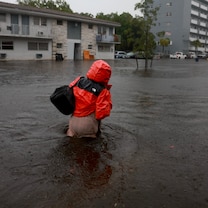
Florida met with heavy rainfall, flooding
- Jun 13, 2:08 PM

SCOTUS strikes down challenge to abortion pill
- Jun 13, 11:28 AM

3 hurt in shooting at Atlanta shopping center
- Jun 12, 11:58 AM

How Trump’s conviction will impact the election
- May 30, 5:23 PM
ABC News Live
24/7 coverage of breaking news and live events
- CruiseMapper
- Ships and Lines
Cruise Ship Norovirus Outbreaks
Here are listed latest cruise ship Norovirus outbreaks on passenger ships, with information what is and how to avoid Norovirus on cruise ships, CDC reports, and news updates.
From the following links, you can skip the intro and jump directly to illness outbreaks in 2024 , 2023 , 2022 , 2020 , 2019 , 2018 , 2017 , 2016 , 2015 , 2014 , 2013 , 2012 , also read about Zika virus , Seasickness , Hospital (shipboard infirmary) and Mercy Ships (hospital ship Africa Mercy) .
Note: The following CruiseMapper link provides information on Coronavirus/COVID outbreaks on cruise ships .
Norovirus outbreaks on cruise ships in 2024
Cruise norovirus outbreaks updates.
Norovirus on ships is spread through contaminated water, foods and surfaces (public restrooms, railings, doorknobs, handles, board games-cards-puzzles-toys, etc). Norovirus withstands chlorine, prolonged exposure outside the body, as well as temperature extremes. Like a virus, Norwalk can't be effectively treated with antibiotics, making it extremely difficult to eliminate in closed environments - like cruise vessels.
Norovirus may incubate up to 48 hours before the symptoms appear. This makes it difficult to restrict an outbreak. Noro symptoms include nausea, vomiting (kids more than adults, abdominal cramps, diarrhea, general weakness, low fever, headache, muscle aches. The illness could last up to 5 days (depending on the person's age, general health, and severity of the exposure to the virus. Recovered patients can still spread the virus for up to 2 weeks.
Quarantining the ill passengers and crew to their cabins is mandatory (at least for 48 hours) to slow the outbreak's spread. Failing to comply with the crew's orders results in fines or even discharge from the ship.
CruiseMapper's Norovirus survey is based on official data from CDC.gov (USA's "Centers for Disease Control and Prevention"). CDC's "Vessel Sanitation Program" assists the cruise tourism industry in preventing and controlling the transmission and spread of gastrointestinal illnesses (Norovirus, ETEC) on passenger ships calling on US seaports.

This program operates under the authority of the Public Health Service Act (fda.gov, "Quarantine and Inspection Regulations to Control Communicable Diseases"). CDC sanitation inspections on passenger ships are conducted twice a year. Scores of 86 are considered passing. Among the issues that CDC health inspectors usually find on board and report are:
- food debris
- dead insects
- insect droppings
- records indicating crewmembers (including cooks and galley staff) working while sick (suffering from gastrointestinal disorders or with acute gastroenteritis/AGE symptoms)
- cracked/corroded equipment
- soiled cutting boards
- food served undercooked
- lack of safety instruction signs.
CDC cruise ship Norovirus reports
Cruise ship outbreaks are reported (posted on the CDC website) when the illness incident meets the following criteria:
- The ship falls within the purview of the Vessel Sanitation Program (VSP). This means if it carries 13+ passengers and has a foreign cruise itinerary with US ports of call in it. Keep in mind, that most departures are from US-based home ports.
- The ship cruise itinerary length is between 3 and 21 days,
- The ship carries 100+ passengers.
- The percentage of infected passengers or crew (cases reported to the ship's med staff) during the cruise is 3% or more. This means small outbreaks on cruise ships will not be reported to the CDC.
CDC cruise ship inspection fees are payable by the shipowner. Fees are based on the vessel's size. VSP doesn't charge fees for consultations related to shipping facilities renovations or new ships. Inspection fees are as follows.
- Small ships (under 3000 GT/gross tons) pay USD 1500 per inspection.
- Small ships (between 3000-15000 GT) pay USD 3000 per inspection.
- Medium ships (between 15000-30000 GT) pay USD 6000 per inspection.
- Large ships (between 30000-60000 GT) pay USD 9000 per inspection.
- Extra-large ships (between 60000-120000 GT) pay USD 12000 per inspection.
- Mega-liners (above 120000 GT) pay USD 18000 per inspection.
Note: When the itinerary doesn't include US cruise ports, the ship is not required to report to CDC, thus no official illness outbreak report would be issued.
CDC ship illness outbreak investigations
VSP (abbrev "Vessel Sanitation Program") monitors CDC's observations on illness patterns for GI (gastrointestinal) outbreaks on passenger shipping vessels ( ferries and cruise ships ).
- VSP conducts outbreak investigations only in cases with 3% or more passengers or crew reported sick with GI symptoms. VSP may also conduct outbreak investigations in cases of unusual GI illness patterns (even if the rate is less than 3%).
- VSP conducts outbreak investigations only on vessels visiting ports in the USA or which are within 15 days of arriving at a US port.
- When an outbreak occurs, VSP asks for ship logs and infirmary records of reported GI cases (symptoms and timing) and illness distribution (among passengers/crew, during each day of the cruise).
- VSP staff usually boards the vessel for epidemiological assessment, interviews, distribution and analysis of illness questionnaires, monitoring cleaning procedures.
- Lab investigations - the onboard med staff often collects stool, vomit, blood specimens, which are then sent to land-based labs to confirm the illness cause.
During the onboard illness outbreak, VSP requires the cruise company to activate the "Outbreak Prevention and Response Plan" (vessel's response to illness cases).
During an outbreak:
- Cleaning and disinfection frequencies are Increased.
- Self-service buffets are stopped.
- All infected (pax/crew) are quarantined to their staterooms/cabins
- Clinical specimens are collected for analysis.
- Daily updates are provided to VSP (cases counts and measures reports)
- All passengers and crew are alerted of the illness.
- Upon boarding on the next scheduled cruise, passengers are notified about the previous voyage's outbreak.
- Occasionally, VSP requires the company to notify port authorities and also to perform cleaning and disinfection in cruise port terminal buildings.
Illness outbreaks on cruise ships (annual statistics)
The following statistics show the number of cruise ship illness outbreaks in recent years. You can compare the number of reports (CDC and news media sources) and the total number of infected (passengers and crew).
In 2014, Time Magazine published the article "The 13 Worst Norovirus Outbreaks on Cruise Ships". In it, the overall winner was Princess Cruises with 5 epidemic illness outbreaks:
- Coral Princess (February 2009, infected 271)
- Crown Princess (January 2010, infected 396)
- Crown Princess (February 2012, infected 363)
- Sun Princess (July 2012, infected 216)
- Ruby Princess (March 2013, infected 276)
Norovirus outbreaks 2023 reports
Norovirus outbreaks 2022 reports, norovirus outbreaks 2020 reports, outbreaks 2019 reports.
In the following table, you can see all 2019-reported Norovirus outbreaks on cruise ships. The listed statistical data is based on CDC or news media reports. It shows the number of sick passengers and crew (with the respective percentage to all), along with the corresponding CDC report pages (if available) as outgoing links.
Note: When the itinerary doesn't include US cruise ports, the ship is not required to report to CDC, thus no official illness report would be issued.
Outbreaks 2018 reports
In 2018, the number of reported illness outbreaks on cruise ships was 15. The total number of infected was 1177 (of those 1099 passengers and 78 crew).
Outbreaks 2017 reports
In 2017, the number of reported illness outbreaks on cruise ships was 21. The total number of infected was 2535 (of those 2450 passengers and 85 crew).
Outbreaks 2016 reports
In 2016, the number of reported illness outbreaks on cruise ships was 23. The total number of infected was 2504 (of those 2378 passengers and 126 crew).
Outbreaks 2015 reports
In 2015, the number of reported illness outbreaks on cruise ships was 23. The total number of infected was 2570 (of those 2458 passengers and 112 crew).
Outbreaks 2014 reports
In 2014, the number of reported illness outbreaks on cruise ships was 17. The total number of infected was 3559 (of those 3354 passengers and 205 crew).
Outbreaks 2013 reports
In 2013, the number of reported illness outbreaks on cruise ships was 22. The total number of infected was 2385 (of those 2249 passengers and 136 crew).
- According to CDC, in 2013 from Norovirus and similar GI (gastrointestinal) illnesses suffered a total of 1409 passengers (which is 7,5% of all passengers on the inspected cruise vessels) and 96 crew/staff members (which is 1,2% of all). With nearly 12 million cruisers departing from USA and Canada ports in 2013, the Norovirus infection rate is ~0,01% of all passengers.
- It should be noted, that in the past years on many CDC inspections was concluded the Noro virus illness source was off the ship.
Outbreaks 2012 reports
In 2012, the number of reported illness outbreaks on cruise ships was 34. The total number of infected was 5542 (of those 5079 passengers and 463 crew).
Norovirus on cruise ships
All important things you should know about the "cruise virus".
Why do Norovirus incidents happen on cruise ships? There are more than 21 million US cases reported annually, of which 1 mill related to kids. Outbreaks happen mostly during winter months and mainly in more crowded places with close quarters. Among those are schools, hospitals, nursing homes, dormitories, prisons, big resorts, bigger passenger ships (including cruise ferries ). Norovirus is often branded as "cruise ship virus" simply because on ships health officials are required to report every gastrointestinal illness incident. This means Norovirus outbreaks are reported more quickly on ships than on land. Just for comparison, the virus can afflict as many as 3000 people per day in only one big city, which is about the passenger capacity of a typical modern cruiser.
What is Norovirus infection? It's a very common, highly contagious, ruthlessly efficient and uncomfortably bad virus affecting the stomach and large intestines. Often called "stomach flu" (the med term is "Gastroenteritis") the infection results in massive vomiting and diarrhea. Sickness outbreaks are considered as such if the percentage of infected people is over 3%. The virus is not seasonal and usually not serious (in medical terms). It hits 1 in 5 people annually and is the cause of ~50% of all foodborne illness outbreaks in the USA and for ~90% of all non-bacterial gastroenteritis worldwide.
The virus is named after an outbreak in Norwalk (OH, USA). Numerous studies confirm that a quick application of hand sanitizer doesn't kill the Norovirus. It takes about 30 sec of hard rubbing with hot water and soap (including under the nails) to wash it. This virus also mutates (changing its strains). As to its efficiency - a mere 20 particles are enough to get you.
What causes Norovirus on cruise vessels is mainly contaminated food/water. When it comes to ships, it spreads mostly through physical contact with sick people or handling contaminated objects. This includes sharing food/utensils and poor hygiene (not washing hands after bathroom use). The virus also spreads fecally, so you can catch it into the onboard laundry, or while changing diapers, etc. However, many passengers likely can blame a sick crewmember for the virus. According to a survey based on 170 inspection records on ships that docked in Florida ports in 2012, on 59 cruises violations of the required illness reporting laws were reported. A total of 130 crew had gotten sick on those voyages and didn't report their illness in the required time period.
The symptoms are nausea, vomiting, diarrhea, indigestion, abdominal cramps. Also possible are mild fever and headache. It takes 1-2 days for the symptoms to appear. The illness lasts 1 to 4 days, but some people (especially elderly) may be contagious for up to 2 weeks after recovery.
What is the treatment? What to do if you got it? Obviously, the first thing is to go to the ship's infirmary (medical center) and contact the doctor. You should drink plenty of water as dehydration is a side-effect of the illness. There is no real treatment for Norovirus - you just wait it out. A few years ago an experimental Norovirus vaccine (applied as nasal spray) was developed by the "Center for Infectious Diseases and Vaccinology" (Arizona State University). The new vaccine generates a good immune response.
How to avoid Norovirus on cruise ships?
- Wash your hands often (hot water and soap), especially before/after eating and after using the bathroom
- Limit physical contacts as much as possible, pack some extra soap, a personal disinfectant (Lysol, Pepto-Bismol), oral rehydration sachets and treatments for diarrhea
- Avoid eating uncooked food (including salads and sandwiches) and food that cannot be washed (unless it can be peeled or shelled), drink only bottled liquids (preferably without ice), don't share drinks/utensils.
- Drink lots of water.
- Compensation for cruise illness. By contract, cruise lines are not required to compensate passengers who fall ill on cruises. However, they will compensate you if the itinerary was altered/canceled due to an illness outbreak. The deal may include up to 50% refund, up to 50% FCC (future cruise booking discount) or an option to cancel for a full refund plus reimbursement of airline change fees. If you have travel insurance, it covers cancellation due to illness. If you've been infected on the ship, it could also cover medical expenses and to compensate you for all days you're not on the ship before the cruise end.
The following "health advisory" list of recommended actions is often issued during gastrointestinal illness outbreak or on embarkation day (of the next scheduled voyage). It has important suggestions on how to avoid spreading the cruise ship virus infection.
- It is critical that excellent standards of personal hygiene are maintained by all on board, as well as avoiding touching surfaces, such as handrails, door handles, elevator buttons, walls.
- Report any observed evidence of vomiting or diarrhea that you may encounter on the ship.
- Ensure that you minimize direct contact with others during this time, such as handshakes, etc.
- Avoid touching your mouth.
- Wash your hands frequently and thoroughly with soap for at least 20 sec and rinse them well under running water. Ensure that you follow this procedure every time you use the WC, after coughing or sneezing, and before eating, drinking or smoking.
- Attempt to always use your own cabin toilet facilities.
- In addition to hand washing, also use the alcohol hand gels provided where available, and in particular before eating in the self-serve buffet restaurant and outdoor food outlets.
- Should you experience any symptoms of vomiting or diarrhea, return to your cabin and immediately report to the Medical Center or Front Office (Reception, if the infirmary is busy) by dialling 999.
Cruise ship virus procedures
What do they do about it? What actions do lines/operators/CDC actually take in response to a Norovirus cruise outbreak?
An "illness outbreak" is considered when 3% or more of all passengers report symptoms to the ship's med staff. In such cases, the CDC requires cruise lines to file a medical report.
The hotel staff is required to implement special cleaning and disinfection procedures for sanitizing the whole ship. To do that, they use stronger solvents, like Microbac, chlorine bleach, hydrogen peroxide. The Lido Deck's bistro/buffet service switches to manned stations. Often, salt-pepper shakers are taken off the tables. The crew starts offering precautionary tips. Sick passengers and crew are quarantined in their rooms, typically for at least 2 days. When Norovirus outbreaks can't be contained, cruise lines might also pull the ship out of service for a few days for sanitizing.
The CDC's "Vessel Sanitation Program" is for monitoring illness outbreaks on passenger ships carrying 100 or more guests on sailings from 3 to 21 days in length. The ship's medical staff is required by the CDC to maintain illness counts for each itinerary involving a stop at a US cruise port and to give CDC the number of all passengers/crew, plus the number of reported diarrhea cases during that voyage. This is done 24 hrs prior to arrival at any US port of call from a foreign port. And they file such reports even if the "illness number" is zero. This protocol only confirms that the CDC knows everything about it.
Other possible actions and results are red level ("Code Red") cleaning. The boarding/embarkation of new passengers is often delayed to permit more extensive disinfection of public areas and the cabins. Usually, a pre-embarkation health advisory is distributed to all boarding passengers. Additional med staff is sent to the ship in port to assist the disembarkation of infected passengers. Another possibility is the cruise ship to cancel all the itinerary's foreign ports of call and to return to its US home-port before the end of the voyage.
Some cruise lines offer hand-sanitizer dispensers near the ship's restaurants, Lido/pool deck areas and other more crowded public spaces in their effort to keep a lid on sickness outbreaks.
In February 2020, the shipowner cruise company Lindblad Expeditions announced the "Premium Purity" program with a shipwide cleaning system based on ACT CleanCoat technology. The program was rolled out fleetwide after a year trial. The innovative ship cleaning process is based on photocatalytic antibacterial spray that when activated by light kills viruses, bacteria, airborne microbes, mould. The disinfecting product and technology were developed by the Danish company ACT Global AS ( Copenhagen ). The spray is chemical-free, odourless, transparent and can be applied to all surfaces.
Zika virus on cruise ships
Zika virus (aka ZIKV) is a Flavivirus - from the genus of the viruses named West Nile, dengue, tick-borne encephalitis, yellow fever. These plus several other viruses may cause encephalitis (acute brain inflammation). In humans, Zika virus causes the Zika fever which is known to occur only within some equatorial regions. In 2014, Zika spread across the Pacific Ocean to French Polynesia, and soon to Easter Island. In 2015, Zika virus reached Central America, the Caribbean, and South America. In South America were recorded several pandemic outbreaks.
The most severe outbreaks were reported in Brazil, with an alarming surge in newborns with microcephaly. If the mother is infected, the virus may cause microcephaly in newborns. This is a neurodevelopmental disorder - babies are born with an underdeveloped head.
Generally, Zika is a mosquito-borne virus spread by Aedes aegypti (aka "yellow fever mosquito") and Aedes albopictus (aka "Asian tiger mosquito"). However, it became "cruise virus" since the decease can also result from intrauterine (contraceptive device), sexual intercourse, blood transfusion, lab exposure, organ/tissue transplantation, breast milk transmission.
In January 2016, the CDC issued travel guidance on affected countries and suggested using enhanced precautions and even postponing travel. Guidelines (specifically for pregnant women) were issued as well. Similar travel warnings were issued by other health agencies and governments. The CDC list of potentially dangerous for travel countries included (alphabetically) Barbados, Bolivia, Brazil, Cape Verde, Colombia, Ecuador, French Guiana, Guadeloupe, Guatemala, Guyana, Haiti, Honduras, Martinique, Mexico, Panama, Puerto Rico, Paraguay, Salvador, Samoa, St Maarten, Suriname, Venezuela.
Cruise lines should warn their pregnant passengers of the virus. Cruise ships publish daily health and safety instructions to their passengers on how to avoid mosquito bites. Zika symptoms are fever, skin rash, pain in joints, conjunctivitis (pink eye). It typically lasts from a few days to a week. For now, the illness cannot be prevented by drugs or vaccines.
"Cruise ship virus" politics
Virus outbreaks on cruise ships are actually not that uncommon. Such viral/bacterial outbreak incidents affect the vacation experience of thousands of people, being packed up in a floating resort for many days on end. In confined spaces with frequent passenger turnover (like big capacity cruise ships), it is easy for diseases to spread - whether food- or air-borne, or otherwise. However, there's a tendency to cover up the severity of this issue.
Some of the world's most famous passenger ships are listed in the virus outbreak statistics, yet one hears so little of it in mass media news. And there is no surprise in that since the "cruise illness" news are nothing but bad publicity for the companies - which is bad for a prosperous multi-billion dollar sea travel vacation business. All major cruise line companies will do their best to keep quiet about virus outbreaks on their ships. There are passenger testimonials about quarantined ships and how badly guests have been treated by the line. Virus outbreak news speaks of a lack of proper hygiene control, badly trained staff, bad ship management. The whole responsibility goes to the shipowner (cruise line company) and its management.
Major (in some cases epidemic) illness outbreaks are among the "biggies" that can bring down the brand's reputation on the market. Cruise illness issues often result in lower booking rates and cheaper prices - which is bad for the business.
So it comes as no surprise that when CDC reports an illness outbreak on some vessel, big media sources do not immediately (or ever) respond to the news. You may hear about it on your local radio station, or on your local cable operator, but not necessarily on ABC, CNN, and often not even on Yahoo and MSN news online. It's not about the passengers' health (never been) - it's about the big money that rules our world.
So keep your hands clean, keep your mind clear, always hope for the best. Bad, if meant to happen, will happen anyway, and nothing can change it.
Seasickness on cruise ships
Seasickness is physical disorientation as a result of conflicting signals received by the brain from different body senses. Our inner ear senses the ship's irregular motion, which our eyes can't see because the floor and walls are stable. Depending on individual balance, our ability to adjust to motions varies, so not everyone experiences seasickness.
Seasickness is one of the most common "cruise illnesses". Passengers sensitive to nausea or motion sickness should consult their doctors for medical recommendations prior to departure. Drugs (like Dramamine) are effective against seasickness. At the cruise ship's Infirmary, and also at Reception Desk is provided (free of charge) Meclizine. Know that the bigger the vessel the more stable it is. Also, motion in midship-located areas (including staterooms) is highly reduced in comparison to forward and aft areas.
Seasickness manifests in different ways and is always a result of the body's attempt to correct for the conflicting inputs received from its senses. Common symptoms are cold sweat, dizziness, drowsiness, headache, nausea. When such symptoms are noticed, passengers should take precautions to prevent intensifying the disorientation. The harder the symptoms, the longer the recovery.
If seasickness symptoms are accompanied by diarrhea or fever, passengers should immediately seek medical treatment for Norovirus and avoid spreading the illness to others.
How to prevent seasickness on cruise ships (tips)
Passengers prone to motion sickness are more likely to suffer seasickness. The following prevention tips can minimize discomfort, so before the cruise:
- choose more sheltered routes (clam waters). Open sea and ocean waters are rough and have larger swells, thus river cruises are among your best choices.
- Choose a large liner as larger vessels are more stable and motions are minimized.
- Book centralized/midship stateroom and/or middle deck cabin, where motions are less noticeable.
- Get a good sleep before the voyage - an energetic, well-rested body adjusts easier to new conditions.
During the cruise tips to divert seasickness symptoms include:
- Get involved in onboard activities - this will occupy your mind while the inner ear adjusts to equilibrium changes.
- Avoid napping or lying down - when the body is horizontal, the ship's motion is more pronounced.
- Avoid eating unknown foods - you don't know how your stomach may react to new food/ingredients. Avoid alcohol and acidic-fatty-spicy foods. Stay well-hydrated by drinking plenty of water.
- Walk around to adjust the body's equilibrium to the ship's motion. When on open decks, focus on the horizon to give your eyes and body similar inputs about any tilting or other motion. Depending on the symptoms' severity, it may take several hours.
- Often get fresh air, take deep breaths, keep your lungs clear.
- Some herbal remedies (in tablets or teas) also can ease the symptoms, including ginger and peppermint. Their efficacy varies by person, and are best used together with other prevention methods.
Search for medical assistance - consult the ship's physician if no actions provide relief.
Cruise ship hospital (medical care)
Cruise vessels are not "hospital ships".
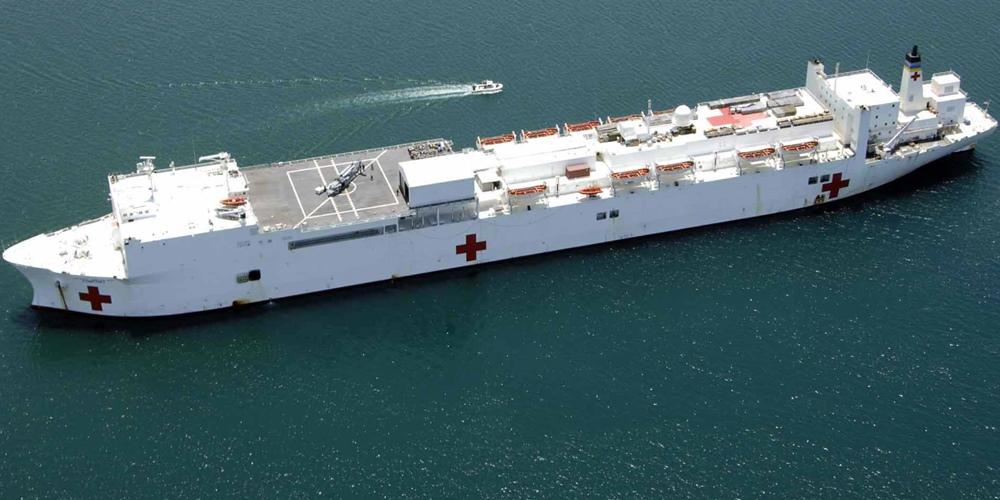
Hospital ships are designated as floating medical facilities (hospitals).
Most hospital ships are navy vessels (operated by military forces) which are specifically built for use in war zones.
Attacking a hospital ship is considered a war crime, but enemy forces have the right to board them for inspections.
As of 2018, hospital ships have Brazil (6), China (5), Russia (6), USA (2), Spain (2), and India-Indonesia-Peru-Vietnam (x1).
The navies of USA, UK, Australia, China, France, Italy, Spain, Argentina, and Japan have some classes of military ships fitted with onboard hospitals.
For passengers with health concerns, medical care on cruise ships is a vital part of their travel planning. Most cruise vessels are equipped with either basic infirmary (a small clinic) or larger hospital where sick or injured passengers are treated and cared for by contractor physicians and nurses on 24-hour duty.
Shipboard hospitals as facilities and equipment vary by cruise line and vessel. Clinic's size usually depends on the ship's capacity (passengers plus crew). Generally, bigger and newer ships offer larger and better-equipped medical facilities and are served by bigger infirmary staff.
The ship's medical personnel are independent contractors. This is for limiting the cruise company's liability. There are no internationally specified regulations governing ship infirmaries and medical staffing. Each company has its own standards provided for its passengers' healthcare.
For finding the Infirmary you can use the ship deck plans . On most vessels, the medical facilities are located midship on a lower deck (for easier access and better stability) and usually among other crew facilities. Every passenger stateroom has the Infirmary's number - posted or by the cabin's phone.
Basic medical care on cruise ships
A cruise ship's medical facility can treat only passengers experiencing minor health issues - seasickness, scrapes, sunburns, etc. More severe medical emergencies can't be handled on the ship and usually require medevacs. Coast guard helicopter teams fly to the ship, hoist the passenger (accompanied by a spouse/relative and a crew nurse) and fly them to the nearest land hospital.
Infirmary's equipment and med supplies provide only emergency response and basic treatments in order to stabilize the passenger until transferred ashore.
In cases of severe emergencies, passengers with life-threatening illnesses or injuries are evacuated off the ship - either by boat (if in or near seaport) or by rescue helicopter dispatched from nearest coast guard or other station. In some cases, nearby ships with better medical facilities may assist.
Both emergency and basic care are available on the ship 24 hours a day. All treatments are paid. Outside regular opening hours fees are higher.
Like inland hospitals, medical treatments at sea are pricey. However, unlike on land, most basic travel insurance policies don't cover medical treatments on cruise ships as they are not from the patient's primary caregiver. Purchasing cruise travel insurance with health coverage (medical clauses) is highly recommended.
Shipboard medical service fees vary and are usually set by medical practitioners. General consultations incur costs similar to home visits. Prescription medications or other treatments cost extra. In most cruise ship hospitals, some supplies and medications are provided to passengers and crew for free - like aspirin, seasickness pills, small bandages.
Mercy Ships
"Mercy Ships" is a charity accredited by Better Business Bureau. It operates hospital ships since 1978 and also has currently the world's largest hospital ship (excluding navy vessels) - MV Africa Mercy.
The organization provides free humanitarian aid worldwide, including health care, community development, and health education projects, mental health, agriculture, and water development programs in mainly developing countries in Africa, Caribbean, South America, Oceania.
The organization's headquarters are in Garden Valley (Texas USA), with another 16 offices worldwide - in UK, Spain, Canada, Germany, France, Denmark, Switzerland, Belgium, Holland, Sweden, Norway, South Africa, Australia, New Zealand, South Korea.
Financial support and supplies are mainly through donations from medical companies (medications, supplies, equipment), corporations (fuel, food, building supplies), governments (port fees, drydock costs), general public and also by the crew (all volunteers on a rotational basis). The crew serves with short-term (2 weeks to 2 years) and long-term (min 2 years) contracts. Volunteer crew members occupy both medical (surgeons, dentists, nurses) and general jobs (deckhands, seamen, engineers, machinists, electricians, teachers, cooks, welders, plumbers, agriculturalists.
The crew on Mercy Ships pay all costs associated with their service - fees, travel expenses, passports, insurance, personal expenses.
As 95 of the world's top 100 largest megapolises are port cities, "hospital ships" could provide healthcare very quickly and more efficiently to large numbers of people.
MV Africa Mercy
MV Africa Mercy is a converted former rail ferry (1980-built as "Dronning Ingrid") drydock-refitted in 2007 at Cammell Laird shipyard (Hebburn, England).
The ship project started in March 1999 with the vessel's acquisition through a donation from Balcraig Foundation (UK), which purchased the boat for US$6,5 million.
Ferry's train deck was reconstructed and converted into a hospital. Project's total cost was over USD 62 million.
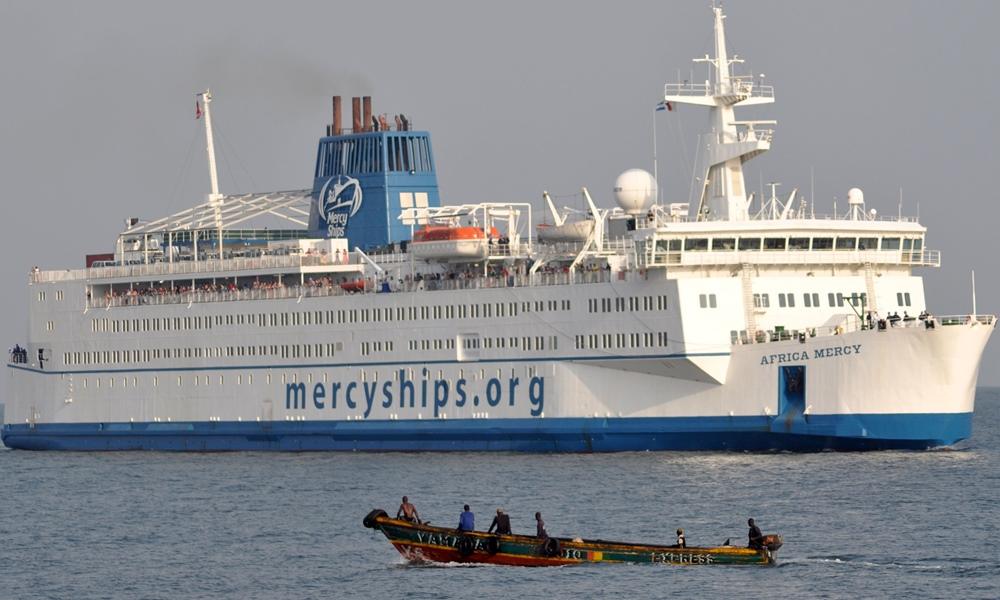
Vessel details include:
- Volume/GT tonnage 16572 tons
- LOA length 152 m (499 ft )
- Width 23,7 m (78 ft)
- Draft 6 m (20 ft)
- Powerplant 4x BW main engines plus diesel generators
- Propulsion two shafts with controllable pitch propellers
- Speed 19 Kn/35 kph/22 mph
- Passenger capacity 484
- Crew capacity 450
- Fleet of 28 vehicles (used in land-based operations)
- Annual drydock maintenance and refurbishment are done in Durban (South Africa).
As for facilities and amenities, the hospital ship has 5 operating rooms, Intensive Care Unit, an ophthalmic unit, CT scanner, X-Ray, labs, recovery ward (82 beds), a daycare center, a school (for all ages), library, launderette, convenience store, restaurant, gymnasium, shops, Starbucks Cafe (donated), satellite communications.
Africa Mercy has a total of 126 staterooms for the staff/crew. They are located on upper decks and include cabins for families, couples and single cabins.
Land-based operations ("Field Service") include mobile clinics providing screening for potential surgery patients, healthcare, dental care, also mental health programs, infrastructure projects.
Notable Norovirus outbreaks on cruise ships

Norovirus is the worst.
Especially when one's aboard a cruise ship.
But good news, the number of outbreaks of Norovirus and other gastrointestinal illnesses on cruise ships has been declining in recent years. The Centers for Disease Control and Prevention recorded 10 outbreaks of gastrointestinal illness on cruise ships in 2018 — the second lowest level since 2001.
Getting passengers to wash their hands frequently while on ships, increasing use of hand-sanitizing gel and better cleaning regimes have helped.
More: Royal Caribbean's Oasis of the Seas cruise ship hit with Norovirus in Jamaica
More: How to stay healthy during flu season
More: Viera Charter School closes early due to Norovirus outbreak
A common "stomach bug" that is widespread across America in the winter, Norovirus hits about 19 to 21 million Americans each year, according to the CDC. Common symptoms include vomiting, diarrhea and stomach cramping. The illness typically comes on suddenly.
Here's a roundup of notable Norovirus outbreaks on cruise ships, according to our archives.
January 2019
A cruise ship carrying 9,000 passengers — including guests and crew members will return to Port Canaveral on Saturday, Jan. 12, — a day earlier than scheduled — after a Norovirus outbreak. The illnesses and the decision to return also prompted Royal Caribbean to issue an apology to the ship's passengers.
Nearly 300 people aboard Royal Caribbean’s Oasis of the Seas – one of the world’s largest cruise ships – came down with Norovirus since the vessel left from Port Canaveral Jan. 6 for a seven-night cruise of the Caribbean.
“All of the ship’s guests will receive full refunds of their cruise fare paid. We think the right thing to do is to get everyone home early rather than have guests worry about their health,” said Owen Torres, a spokesman for Royal Caribbean Cruises .
“Returning on Saturday also gives us more time to completely clean and sanitize the ship before her next sailing. Our guests sail with us to have great vacations, and we are sorry this cruise fell short.”
The outbreak was bad enough that the 18-deck mega-ship docked in Jamaica without passengers being able to leave.
Officials reported more than three dozen people were ill from the Norovirus while onboard a cruise ship sailing to ports in California.
Princess Cruises spokeswoman Karen Candy said about 37 passengers on the Crown Princess reported being sick while the ship was in San Francisco. The Crown Princess was on a seven-day California cruise that began in Los Angeles and ended in Santa Barbara.
February 2014
• A Holland America ship was hit by a possible norovirus outbreak . About 114 passengers and 10 crew members became sick with vomiting and diarrhea on the sailing of the Veendam, which completed a 14-day cruise. The ship carried 1,273 passengers and a crew of 575.
• Princess Cruises' Houston-based Caribbean Princess returned to its home port more than 24 hours early in the wake of an outbreak of gastrointestinal illness.
More than 160 of 3,104 passengers on the vessel had fallen ill with a gastrointestinal illness that the cruise line suspected was norovirus.
January 2014
• Nearly 700 passengers and crew members became ill during a cruise on Royal Caribbean's Explorer of the Seas. The voyage was cut short and the ship returned to port in Bayonne, N.J.
The CDC reported those sickened included 630 passengers and 54 crew members. The ship, scheduled for a 10-day cruise, was carrying 3,050 passengers. Health investigators suspected norovirus.
The cruise line said most guests who fell ill were up and about as the ship headed to port. It said seven people were still sick when the ship reached Bayonne, but that none of the passengers had to be hospitalized.
• Scores of passengers on a four-night cruise out of Miami aboard a Royal Caribbean International ship became sick, according to media reports. The Miami Herald and New York Daily News said 66 guests and two crewmembers aboard the ship Majesty of the Seas suffered a gastrointestinal illness believed to be norovirus. The ship returned to port after a trip to the Bahamas and Key West. Royal Caribbean officials confirmed the illness of 68 people among 2,581 guests and 844 crew members, the Daily News reported.
October 2013
More than 300 passengers and crew on Celebrity Cruises' Celebrity Summit were hit with a stomach bug identified as norovirus, according to the CDC.
The ship was on a two-week Canada/New England sailing, which embarked from Bayonne, N.J., on Sept. 21.
In response to the outbreak — which the CDC said affected 14.5 percent of passengers and 1.5 percent of crew onboard — a beefed up cleaning and disinfection plan was put in place on the ship.
A Royal Caribbean International cruise ship returned to Port Everglades in South Florida, concluding a voyage that saw more than a hundred people develop a gastrointestinal illness. The cruise line reported 105 of 1,991 guests and 3 of 772 crew members experienced a possible norovirus during the 11-night trip.
February 2012
• Princess Cruise Lines said 92 passengers and 13 crew members aboard the Ruby Princess were affected by the norovirus. The ship, carrying just over 3,000 passengers, returned to Port Everglades in Miami and was disinfected.
• A second ship, Crown Princess, had reported passengers and crew members getting sick, but spokeswoman Julie Benson said the cause of the illnesses was not known. A total of 140 passengers and 18 crew members were affected by the illness. The ship returned to Port Everglades and returned to sea later that night. All cabins and public areas on the ships were disinfected, which briefly delayed their next departures. The ship also had been carrying just over 3,000 passengers.
• Royal Caribbean's Voyager of the Sea left New Orleans a couple of hours late because of the same illness.
A total of 100 people aboard a cruise ship fell ill from a gastrointestinal illness, Royal Caribbean Cruises said. The company said 89 of the people who got sick were guests, and the rest were crew members on the Celebrity Cruises ship called Zenith. The ship was carrying 1,363 guests and 613 crew members.
The ship left the Port of Tampa on April 2 and returned as scheduled.
The illness was thought to have been caused by a norovirus, the Miami-based company said.
December 2006
The then world's-largest cruise ship was held in port for intensive cleaning after a second outbreak of gastrointestinal illness in two voyages sickened several hundred people.
More than 380 passengers and crew members aboard Royal Caribbean's Freedom of the Seas were sickened by norovirus during a Nov. 26-Dec. 3 Caribbean cruise. The ship was cleaned before its next cruise, but 97 passengers and 11 crew members became sick with the same illness the week after, officials at the Miami-based cruise line said. The ship carried more than 3,900 passengers.
Another ship, Princess Cruises' Sun Princess, underwent a thorough cleaning after docking at Port Everglades with 103 sick passengers.
"This is not a very serious outbreak, but we did treat it as we treat all increased incidents — very immediately and swiftly," said Julie Benson, spokeswoman for Santa Clarita, California-based Princess. The ship carried about 1,950 passengers.
November 2006
Nearly 700 passengers fell ill on the Carnival Liberty during a cruise, and two men died while on that cruise.
Carnival said neither death was related to the virus, which had infected several guests before they boarded Nov. 3 in Rome and then spread to 536 guests and 143 crew members.
The Liberty, which made its maiden voyage in July 2005, was then considered one of the world's largest cruise ships, with 13 passenger decks and room for 2,974 travelers.
More than 300 passengers aboard Mariner of the Seas caught an illness caused by the norovirus. After a cleaning, the ship left Port Canaveral bound for the Caribbean. Michael Sheehan, spokesman for Royal Caribbean, said the norovirus afflicted 328 of the 3,660 passengers on a seven-day voyage.
More than 200 Royal Caribbean cruise passengers returned to Miami after getting sick aboard a seven-night excursion. A statement from the company said 243 passengers and 19 crew members aboard Explorer of the Seas suffered from a gastrointestinal illness believed to be norovirus. There were just over 3,250 passengers on board.
January 2006
In 2006, hundreds of cruise ship passengers came down with norovirus twice aboard Royal Caribbean's Mariner of the Seas. During a weeklong cruise in January, 276 of 3,465 passengers (7.9 percent) and 27 of 1,190 crew members (2.2 percent) were reported ill from the norovirus.
February 2004
A Carnival Cruise Lines ship returned to Galveston, Texas, from a five-day cruise to Mexico with more than 300 people sick with a gastrointestinal illness.
December 2003
Fifty-three passengers and 11 crew members on Holland America Line Inc.'s Volendam came down with probable cases of norovirus, CDC spokesman Tom Skinner said.
The ship carried about 1,400 passengers and about 600 crew members, so about 3.2 percent of people onboard were sick. The ship returned to Port Everglades in Fort Lauderdale after completing a seven-day cruise in the Gulf of Mexico and the Bahamas.
Contributing: Gene Sloan of USA TODAY , JD Gallop of FLORIDA TODAY, AP
Sangalang is a digital producer at FLORIDA TODAY .
Contact Sangalang at 321-242-3630
Twitter: @byjensangalang
Support local journalism: Subscribe to FLORIDA TODAY at floridatoday.com/subscribe.
We tested hundreds of beauty products — here are our 2024 award winners!
- Share this —

- Watch Full Episodes
- Read With Jenna
- Inspirational
- Relationships
- TODAY Table
- Newsletters
- Start TODAY
- Shop TODAY Awards
- Citi Concert Series
- Listen All Day
Follow today
More Brands
- On The Show
- TODAY Plaza
Norovirus outbreaks on cruise ships surge to decade-high levels: How to avoid the stomach bug
In 2023, a decade-high number of cruise ships have reported an unwelcome passenger on board: norovirus.
Outbreaks of the stomach bug have surged on cruise ships this year, reaching the highest levels seen in 10 years. Since January 2023, there have been 13 confirmed norovirus outbreaks on cruise ships under U.S. jurisdiction — that's more outbreaks in six months than there have been during any full year since 2012, according to data from the U.S. Centers for Disease Control and Prevention .
After a lull during the COVID-19 pandemic, cases of the highly contagious virus that causes diarrhea and vomiting, aka stomach flu, spiked this winter and spring on land. As post-pandemic travel surges and millions of Americans return to cruise ships, an increasing number of cruise lines are reporting outbreaks at sea.
Norovirus outbreaks on cruise ships
Most recently, a norovirus outbreak in June on the Viking Neptune sickened 110 passengers (over 13% of the ship's guests) and nine crew members with vomiting, diarrhea and abdominal cramps, according to the CDC . The CDC has tracked outbreaks of gastrointestinal illness on cruise ships through its Vessel Sanitation Program (VSP) since 1994.
Several weeks prior, a Celebrity Summit cruise ship reported an outbreak of norovirus that sickened more than 150 passengers and 25 crew members, per the CDC . It was the third norovirus outbreak on a Celebrity Cruises vessel this year. Another popular cruise line, Royal Caribbean International, has reported four outbreaks since January.
Cruise ships are required to report cases of gastrointestinal illness to the CDC before arriving at any U.S. port, and the CDC will notify the public about outbreaks if they meet certain criteria, including: the ship is carrying 100 or more passengers, the voyage is three to 21 days long, and 3% or more of passengers or crew report symptoms, per the CDC .
The number of outbreaks in the first six months of 2023 is higher than the yearly total during every year since 2012, when there were 16 outbreaks on cruise ships reported to the CDC.
Norovirus can spread year-round, but it tends to have a wintertime seasonality and peak during the colder months. Outbreaks are most common between November and April, TODAY.com previously reported.
"It's a virus we typically see all throughout spring, so it’s not unusual to be see cases in April and May, (and) we are continuing to see many cases now," Dr. Luis Ostrosky, an infectious disease specialist at UTHealth Houston and Memorial Hermann in Houston, tells TODAY.com.
However, as travel surges this summer, travel-related illnesses are expected to surge, as well. “I think our travel frenzy after COVID is partially fueling this continued spread (of norovirus),” says Ostrosky.
What should people know about norovirus and how to avoid getting sick on cruise ships this summer?
Norovirus symptoms and treatment
The most common symptoms of norovirus are vomiting, nausea, diarrhea and abdominal pain, Dr. Albert Ko, infectious disease physician and professor of public health, epidemiology and medicine at Yale School of Public Health, tells TODAY.com.
Less commonly, norovirus may cause a headache, muscle aches, or a low-grade fever — symptoms usually develop within one to two days after exposure to the virus, per the CDC .
In the vast majority of people, norovirus symptoms will last several days and resolve on their own.
There’s no specific treatment or antiviral for norovirus, according to Ostrosky, but most cases can be managed at home with supportive care like hydration and rest. Sick people should also isolate until their symptoms resolve, the experts emphasize.
Some people are at higher risk of developing severe norovirus symptoms — these include infants, the elderly, and people with compromised immune systems, Ostrosky noted.
How does norovirus spread?
Norovirus is highly contagious and can spread directly through sick people and contaminated surfaces, food, or drinks.
Transmission often occurs when tiny virus particles in feces or vomit from an infected person end up in another person's mouth through direct contact or by touching contaminated surfaces and putting unwashed hands in the mouth or nose, TODAY .com previously reported .
Norovirus can also get into food before, during or after preparation, and it's the top germ causing foodborne illness in the U.S., per the CDC . Virus particles can contaminate drinking water that isn't treated properly or pools when people poop in the water.
It only takes a small number of virus particles for norovirus to spread, which is why norovirus causes so many explosive outbreaks, Ko previously told TODAY.com.
Exposure to less than 100 norovirus particles can make someone sick, and infected people typically shed billions of particles, according to the CDC.
Most people are infectious from symptom onset until about two or three days after recovering, but some people can remain contagious for weeks, Ko notes. People can get infected with norovirus multiple times in their lifetime.
Is norovirus common on cruise ships?
Certain environments are more conducive to the virus spreading. According to the CDC , the most common settings for norovirus outbreaks are health care facilities, restaurants or catered events, schools, day cares and, of course, cruise ships.
Cruise ships are often associated with norovirus because of the enclosed spaces, close living quarters, communal dining and high turnover of passengers, experts note. That said, outbreaks of acute gastrointestinal illnesses are relatively infrequent on cruise ships compared to settings on land, the CDC notes .
How to avoid norovirus on a cruise
Hand hygiene is key to prevent the spread of the highly contagious virus — but the way you clean your hands matters, experts note. It has to be with soap and water, because alcohol-based hand sanitizers are not effective against norovirus.
“Norovirus is one of the few viruses that doesn’t get deactivated by alcohol. You actually need to use soap and water to physically destroy it and remove it from your hands,” Ostrosky previously told TODAY.com.
It's important to wash your hands with soap and clean water frequently, but especially after using the bathroom or changing diapers, before eating and before touching your face.
Surfaces or objects that are contaminated with norovirus can be cleaned with a high-level disinfectant like bleach, per Ostrosky.
On cruise ships, avoid sick people if you can. Passengers who experience norovirus symptoms like vomiting and diarrhea should notify staff and follow recommended precautions, per the CDC .
Caroline Kee is a health reporter at TODAY based in New York City.
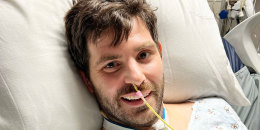

EXCLUSIVE: Man, 32, becomes fully paralyzed within days of catching COVID due to rare syndrome

Comedian Keith Robinson gives health update on stroke recovery ahead of new Netflix special

1st human to contract H5N2 bird flu dies in Mexico: What to know about symptoms

Boy diagnosed with testicular cancer at 16 recalls early symptom: ‘I thought it was normal’

EXCLUSIVE: Teen’s heart stopped 400 times in a week. Doctors were stunned to find out the cause

How is Bruce Willis' health? What to know about his frontotemporal dementia diagnosis

Mom, 33, worried for years her mole was cancer. Doctors dismissed it. Her 2-year-old saved her

Mom noticed a port wine birthmark above her daughter's eye. It was sign of seizure-causing condition

Peter Alexander’s sister Rebecca opens up about Usher syndrome, vision and hearing loss at age 12

Colon cancer is becoming more common in pregnancy: 2 women recall symptoms that doctors dismissed
A .gov website belongs to an official government organization in the United States.
A lock ( ) or https:// means you've safely connected to the .gov website. Share sensitive information only on official, secure websites.
- Vessel Sanitation Program
- Stay Healthy on Your Cruise
- Meetings & Announcements
- Vessel Sanitation Training
- Data Summary
- Public Health Resources
- Addressing AGE on Cruise Ships
Earlier Outbreaks on Cruise Ships in VSP's Jurisdiction
At a glance.
Learn more about outbreaks of gastrointestinal (GI) illness on cruise ships from 2019 through 2023 in the Vessel Sanitation Program's (VSP) jurisdiction.

Earlier outbreaks (2023)
Earlier outbreaks (2019-2022), about outbreak reporting.
We post outbreaks when they meet all the following criteria:
- Ship is under VSP jurisdiction (on voyages including both U.S. and foreign ports)
- Ship carries 100 or more passengers
- Voyage is 3-21 days long
- Voyage has 3% or more of passengers or crew reporting symptoms of GI illness to the ship's medical staff
We may also post information on outbreaks of public health significance that do not necessarily meet the above criteria.
Notes about the data
GI illness is a commonly used term for acute gastroenteritis (AGE).
Cruise ships report cases that meet our case definition for AGE. We define a reportable case of AGE as:
- Three or more loose stools within a 24-hour period or what is more than normal for that person OR
- Vomiting along with one of the following symptoms: diarrhea, muscle ache, headache, abdominal cramp, or fever.
What case totals mean
Learn how passengers can protect themselves with these tips for healthy cruising .
Find more information on
- VSP outbreak response
- Recent outbreaks
- Archived outbreaks (1993–2018)
Read our publication on cruise ship GI outbreaks during 2006-2019.
The Vessel Sanitation Program helps the cruise ship industry prevent and control the introduction and spread of gastrointestinal illnesses on cruise ships.
For Everyone
Public health.
How common is norovirus on cruise ships? Here’s why you shouldn’t worry

What's sneaky, super contagious and bound to cause diarrhea and vomiting? If you answered "norovirus," you'd be correct. But what is it, and why is it often associated with cruises?
An excessive number of news reports exist for norovirus cases on ships, making it seem to the unsuspecting public that cruise vessels are dirty or you're likely to get sick if you sail . I'm here to set the record straight.
Find out why norovirus is unfairly labeled a cruise ship illness, what cruise lines do to minimize onboard spread and whether you should be worried about it on your next voyage.
For more cruise news, guides and tips, sign up for TPG's cruise newsletter .
What is cruise ship norovirus?

Norovirus is the most common of several viruses that cause severe gastrointestinal illness or acute gastroenteritis. Symptoms may include diarrhea and vomiting, as well as abdominal cramping, headaches, muscle aches and fever — an unpleasant experience any time but especially when you're on vacation.
Norovirus is highly contagious and spreads when you touch a contaminated surface and then put your fingers in or near your mouth, such as when eating without washing your hands. It's also frequently spread through contaminated food, sometimes earning it the nickname "food poisoning," even though there are many pathogens that can cause foodborne illnesses. You might also hear it generically called a stomach bug or the stomach flu despite the fact that noroviruses are not the same as flu viruses.
How does norovirus spread on cruise ships?
What causes norovirus on cruise ships, anyway? Norovirus spreads easily in close quarters, such as those found on cruise ships. Although it can spread from person-to-person contact, on vessels, it's most commonly passed when passengers fail to wash their hands after coming in contact with high-touch areas, such as handrails, elevator buttons and serving utensils in the onboard buffets.
Infected passengers who don't wash their hands after coughing, sneezing or using the restroom are the reason those surfaces become contaminated in the first place. To avoid both spreading your own germs and picking up the germs of others, wash your hands frequently, especially before eating, for at least 20 seconds with soap and warm water, making sure to scrub around your fingernails and between your fingers.
Contaminated food is also a cause, but it's not as common on ships, where the staff is meticulously trained to follow health and safety guidelines for sanitation. Standards are enforced by the U.S. Centers for Disease Control and Prevention. (See the next section for more.)
What do cruise ships do to prevent norovirus outbreaks on board?

Cruise lines employ crews dedicated to keeping public areas and high-touch surfaces clean. Galley crews and waiters receive extensive training on food safety and handling.
Lines also screen passengers for signs of illness at embarkation. They ask passengers who feel ill during their cruises to report symptoms to the medical center and keep themselves isolated in their cabins.
On ships where outbreaks occur, the crew conducts a deep cleaning of the ship after passengers have disembarked and before the next sailing begins. In cases where outbreaks are particularly severe, subsequent sailings could be canceled to allow for more thorough sanitization.
Additionally, the CDC's Vessel Sanitation Program, implemented in the 1970s, subjects all passenger ships carrying 13 or more people to random, unannounced inspections if they wish to call on ports in the United States.
As part of the program, ships are required to adhere to stringent health and safety protocols that dictate everything from the cleaning of high-touch areas to how food is stored in freezers, refrigerators and galleys.
VSP inspectors board ships and conduct thorough checks to ensure compliance, and the standards are high. A score of less than 86 out of 100 is considered failing. You can find a list of the most recent inspection scores and lists of violations for each ship on the VSP website .
Should you worry about getting norovirus on a cruise?
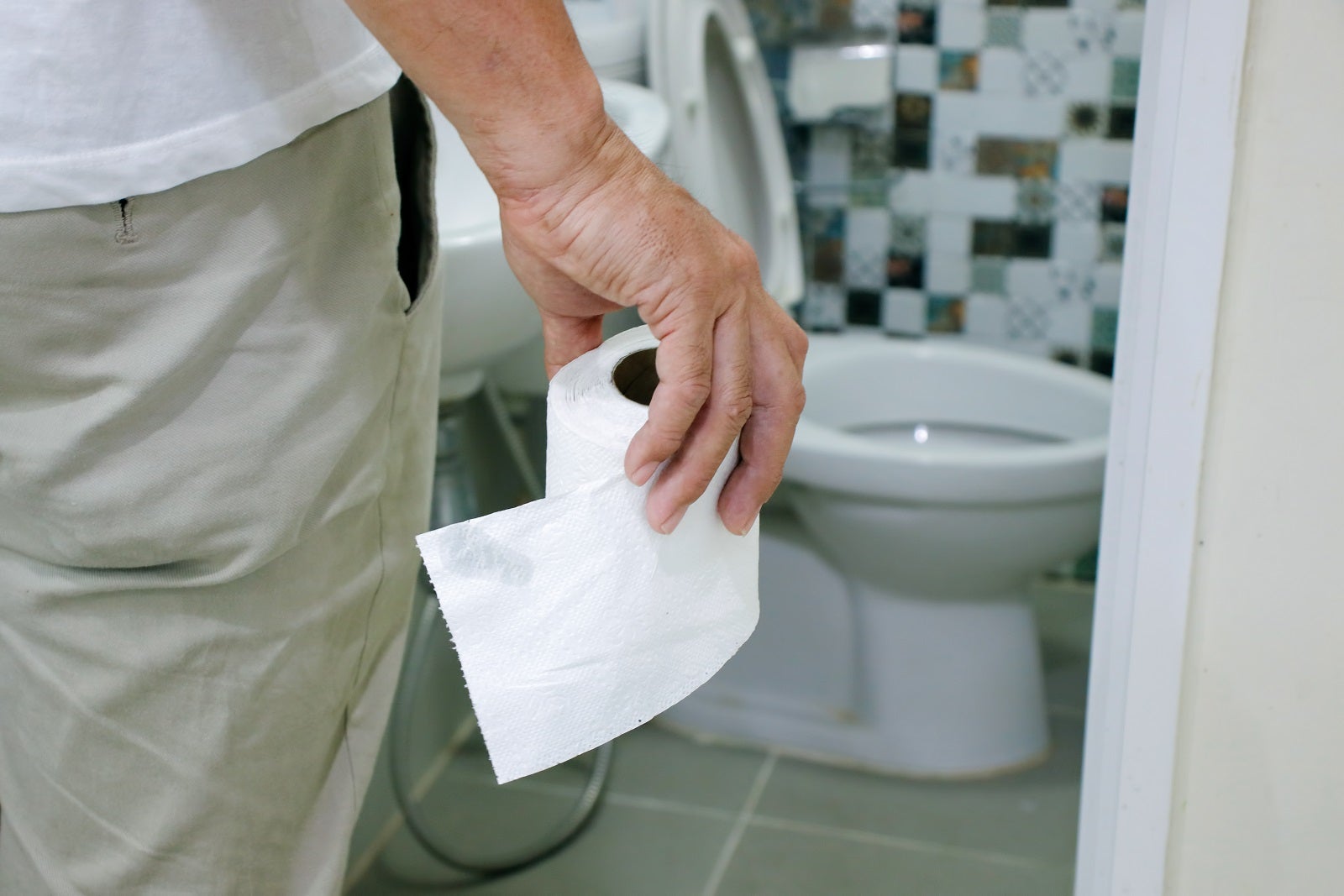
The short answer is no. "People often associate cruise ships with acute gastrointestinal illnesses, such as norovirus, but acute gastrointestinal illness is relatively infrequent on cruise ships," the CDC says on its " Facts About Noroviruses on Cruise Ships " page.
Based on the math, you have less chance of catching a gastrointestinal illness on a ship than at many places you're likely to visit on land.
The CDC estimates only about 1% of all annual U.S. norovirus cases happen on cruise ships. The numbers are greatest in nursing homes, hospitals, schools and restaurants, which collectively account for about 91% of cases.
In a study of acute gastroenteritis cases from 2006 to 2019 (before the cruise industry's COVID-19 shutdown), the CDC found that the number of cases on ships decreased over those 14 years. It also noted that the number of cases tends to be higher on larger ships and on voyages of a week or longer.
"The rate of … illness on cruise ships decreased during 2006-2019 for passengers and crew," the report says. That's good news for cruisers.
During that time frame, approximately 127 million passengers sailed on the 252 cruise ships under VSP jurisdiction. Of those 127 million cruisers, 26,450 reported symptoms of gastrointestinal illness while on board. It sounds like a large number, but it amounts to just 0.02% (two one-hundredths of one percent) of cruisers throughout those 14 years, with the total number of cases decreasing from 4,507 in 2006 to 1,201 in 2019.
If you'd like to check out the outbreak information, you can find a detailed list of ships that have had acute gastroenteritis outbreaks (many of which were caused by norovirus), listed by year, about halfway down the CDC's outbreak page .
For more details on how to keep yourself healthy on board, visit TPG's story on how to avoid getting sick on a cruise .
Why are there so many cruise norovirus reports on the news?

The simple answer is that cruise ships are required to report cases of acute gastroenteritis to the CDC, even when the numbers are low. In contrast, other entities — schools, nursing homes, hospitals and restaurants — are not.
"Health officials track illness on cruise ships. So outbreaks are found and reported more quickly on a cruise ship than on land," reads the CDC's facts page .
Specifically, the medical staff from each cruise ship must submit a report with the number of ill passengers within 24 to 36 hours of its arrival at a U.S. port from a foreign port, even when no cases of gastrointestinal illness are present. They must also submit reports if 2% or more of the passengers and crew become ill and the ship is scheduled to visit a U.S. port within 15 days. If the number hits 3% or more, cases must be reported to the CDC even if the ship is not scheduled to call on a U.S. port within the next 15 days.
That means data for norovirus on cruise ships is more readily available than for other entities. It's easy to make norovirus case numbers sound alarming, but context matters. For example, 100 cases on a single ship might seem like a lot, but on a vessel like Oasis of the Seas, which carries more than 5,400 passengers, 100 cases are only about 2% of the onboard population.
Bottom line
Should you be worried about catching norovirus or another gastrointestinal illness when you cruise? The CDC says cruises account for some of the lowest case numbers in the U.S. annually.
Your chances of finding yourself confined to your room and hunched over a toilet for a week are slim when you sail, especially if you take common-sense precautions like washing your hands and not sharing drinks, utensils and other items that easily spread germs.
Have more cruise questions? TPG has answers:
- Are cruises safe? Here's what you need to know before you sail
- Packing for a cruise? These items aren't allowed on board
- Man overboard: Cruise ship overboards and how they happen
- What is baked Alaska, and why is it paraded around cruise ships?
- What are the largest cruise ships in the world?
- Gentlemen hosts: These men cruise to make sure single ladies have a great time
- What is the Jones Act and how does it affect cruise ships?
- What is a lido deck on a cruise ship?
- What's a cruise cabin guarantee and will it save you money?
- What's the difference between a cruise ship concierge and a butler?
An official website of the United States government
The .gov means it’s official. Federal government websites often end in .gov or .mil. Before sharing sensitive information, make sure you’re on a federal government site.
The site is secure. The https:// ensures that you are connecting to the official website and that any information you provide is encrypted and transmitted securely.
- Publications
- Account settings
Preview improvements coming to the PMC website in October 2024. Learn More or Try it out now .
- Advanced Search
- Journal List
- MMWR Morb Mortal Wkly Rep
- v.69(16); 2020 Apr 24

Notes from the Field: Multiple Cruise Ship Outbreaks of Norovirus Associated with Frozen Fruits and Berries — United States, 2019
Jared r. rispens, amy freeland, beth wittry, adam kramer, leslie barclay, jan vinjé, aimee treffiletti, keisha houston.
From July to September 2019, cruise line X experienced sudden, unexplained outbreaks (>3% of the passenger population) of acute gastroenteritis (AGE) among passengers on 10 cruise ships sailing in Europe. The rapid onset of vomiting and diarrhea followed by recovery within 24 hours were consistent with norovirus infection. Investigations by the cruise line throughout the summer yielded no clear source of the outbreaks even after extensive food testing. On September 18, 2019, CDC’s Vessel Sanitation Program (VSP) was notified of an outbreak of AGE on cruise ship A of cruise line X, sailing into U.S. jurisdiction (defined as passenger vessels carrying ≥13 passengers sailing to the United States from a foreign port) from Germany to New York City ( 1 ). By the end of the 19-day voyage on September 23, a total of 117 of 2,046 (5.7%) passengers and eight of 610 (1.3%) crew members met the case definition for AGE (three or more loose stools within a 24-hour period or more than normal for the patient, or vomiting plus one other sign or symptom including fever, diarrhea, bloody stool, myalgia, abdominal cramps, or headache). Four stool specimens were collected and tested for norovirus at CDC’s National Calicivirus Laboratory; three tested positive for norovirus by quantitative reverse transcription–polymerase chain reaction (RT-PCR). No outbreak source was determined after a field investigation by a VSP team on September 22.
The following month, on October 7, CDC’s VSP was notified of two more outbreaks in U.S. jurisdiction. The first outbreak occurred on another ship (ship B) of cruise line X sailing to and from New York City along the eastern seaboard and affected 85 (3.9%) of 2,166 passengers and 10 (1.6%) of 612 crew members; the second outbreak occurred on ship A sailing from Montreal to New York City and affected 83 (3.7%) of 2,251 passengers and 10 (1.6%) of 610 crew members. VSP again conducted outbreak investigations on October 12 (ship B) and October 13 (ship A). Five stool specimens from ship B and two from ship A were collected for laboratory testing. During the field investigations, cruise line X’s public health officials reported to VSP that after reviewing food questionnaires completed by ill passengers on ship B, nearly 80% of completed questionnaires implicated a smoothie made from frozen fruits and berries. Because of the epidemiologic link and because berries have been implicated in past outbreaks ( 2 , 3 ), CDC requested assistance from the Food and Drug Administration (FDA) to collect frozen fruit and berry items from ship B for norovirus testing. Food item lot numbers from ship B matched those from the same frozen fruit and berry items on ship A.
Overall, nine of 11 stool samples from the three outbreak voyages on ships A and B tested positive for norovirus by quantitative RT-PCR at CDC; these included three of four from ship A’s first voyage, four of five from ship B, and two of two from ship A’s second voyage. The samples were typed as GII.2[P16]. FDA tested 16 frozen fruit and berry items, and three items tested positive for norovirus: raspberries (norovirus genogroup II), tropical fruit cocktail (norovirus genogroup I), and berry mix (norovirus genogroup I). Norovirus sequences from the stool samples and from raspberries were 97.5% similar. After removal of the fruit items, no further outbreaks were reported on cruise line X.
Upon further review of food provisioning, cruise line X determined that its food vendor had purchased several containers (nearly 22,000 pounds) of frozen raspberries of the same lot from a supplier in China beginning the end of June 2019. These raspberries had been supplied to the entire fleet of cruise line X. Both the epidemiologic and laboratory data implicated the raspberries as the cause of the outbreaks. As a result of these findings, on November 11, the World Health Organization issued a recall notice * for frozen raspberries traced back to China. This investigation highlights the importance of AGE surveillance at sea to prevent transmission of AGE illness through U.S. ports and to identify contaminated foods at sea that had not yet been implicated on land.
Acknowledgments
Aron Hall, Division of Viral Diseases, National Center for Immunizations and Respiratory Diseases, CDC; Meghan Holst, ORISE fellow, Division of Environmental Health Science and Practice, National Center for Environmental Health, CDC; Nicole Vaught, Food and Drug Administration (FDA); Yuyan Liang, Tracy Portelli, FDA; FDA food laboratories.
All authors have completed and submitted the International Committee of Medical Journal Editors form for disclosure of potential conflicts of interest. No potential conflicts of interest were disclosed.
* https://webgate.ec.europa.eu/rasff-window/portal/?event=notificationDetail&NOTIF_REFERENCE=2019.3843 .
- Search Please fill out this field.
- Manage Your Subscription
- Give a Gift Subscription
- Newsletters
- Sweepstakes
Highest Number of Norovirus Outbreaks on Cruise Ships Recorded in 11 Years
The highly contagious gastrointestinal illness has spread on 13 cruise ships — so far — this year
There have been 13 outbreaks of the wildly contagious norovirus on cruise ships this year — the highest number since 2012.
And it’s only July.
The most recent outbreak occurred on the Viking Neptune , where about 13% of the 838 passengers on the ship contracted the illness. That’s the highest percentage of passengers to fall ill from norovirus so far, according to the CDC.
“We believe the gastrointestinal illness originated from a shoreside restaurant in Iceland where a group of guests dined during their free time,” a Viking representative told CNN .
Often dismissed as a “stomach flu,” norovirus is a highly contagious gastrointestinal illness that causes vomiting and diarrhea. In fact, it isn’t related to the flu at all.
And the way the virus spreads is almost as unpleasant as the illness itself.
“You can get norovirus by accidentally getting tiny particles of feces (poop) or vomit in your mouth from a person infected with norovirus,” says the CDC.
And if someone has norovirus and is preparing your food, there's a good chance they can spread the illness to you—especially if they haven't washed their hands properly.
The CDC says you can also get it from “touching surfaces or objects contaminated with norovirus and then putting your unwashed fingers in your mouth" — which is why cruise ships like the Viking Neptune enacted its “increased cleaning and disinfection” procedure following the outbreak.
And while it may seem like cruise ships are a breeding ground for gastrointestinal illnesses like the norovirus, the CDC says that’s not the case.
“Acute gastrointestinal illness is relatively infrequent on cruise ships,” the agency says . “Health officials track illness on cruise ships. So outbreaks are found and reported more quickly on a cruise ship than on land.”
And while there have been 13 cases of norovirus diagnosed so far this year, the CDC isn't recommending that people avoid cruises — which they did when the highly contagious Covid variant, Omicron, was spreading in late 2021.
However, the Covid-era recommendation to wash your hands with soap and warm water for at least 20 seconds can also help avoid the spread of norovirus, the CDC says .
Hand sanitizer, on the other hand, “does not work well." The Mayo Clinic echoes this, recommending plain old soap and water over alcohol-based sanitizers.
And since norovirus spreads easily through food prep, the CDC recommends that shellfish be cooked thoroughly to an internal temperature of at least 145°F — as “quick steaming processes may not heat foods enough to kill noroviruses.”
Symptoms can kick in as early as 12 hours after exposure to the norovirus, and can last up to three days.
And although vomiting, diarrhea and stomach pain are unpleasant, most symptoms resolve on their own , with patients being advised to stay hydrated and use over-the-counter solutions (such as anti-nausea or anti-diarrheal medication) to ease symptoms.
However, "for some people — especially young children, older adults and people with other medical conditions — vomiting and diarrhea can be severely dehydrating and require medical attention."
Warning signs of dehydration include fatigue and dry mouth. Parents are cautioned to monitor their children, as those "who are dehydrated might cry with few or no tears. They might be unusually sleepy or fussy."
In these extreme cases, via intravenous hydration might be required.
Never miss a story — sign up for PEOPLE's free daily newsletter to stay up-to-date on the best of what PEOPLE has to offer, from juicy celebrity news to compelling human interest stories.
Related Articles
- Search the site GO Please fill out this field.
- Newsletters
Norovirus Outbreaks on Cruise Ships: How to Avoid Getting Sick on Vacation
:max_bytes(150000):strip_icc():format(webp)/7cZXd_5cLI7mNtZRS31XzPzGTeA8lh_k24WTXKJk-mo-3956d73663764f15bce8e3e4ea4d59fa.jpeg)
- There have been 13 norovirus outbreaks on cruise ships in 2023.
- Experts note that the highly congested environment, as well as the fact that people have not been exposed to as many illnesses due to the COVID-19 pandemic, are likely the reason for the increased norovirus numbers.
- Experts recommend maintaining proper hygiene habits and contacting the ship’s medical facility as soon as you don’t feel well in order to avoid spreading illnesses while at sea.
Multiple cruise lines are experiencing norovirus outbreaks.
There have currently been 13 norovirus outbreaks on cruise ships in 2023. The most recent outbreak occurred on a Viking Cruises ship, which traveled from Iceland and docked in New York City. About 13% of its passengers and several crew members became ill with the virus while on board.
With more than 31 million passengers worldwide expected to set sail this year, experts told Health that these highly-congested environments—along with the fact that people have not been exposed to a normal amount of illnesses due to the pandemic—could be the reasons for the increased numbers.
“Loosening of restrictions after the COVID-19 pandemic makes us more susceptible to picking up viruses after several years in seclusion,” Sanjiv Shah, MD, MPH , an infectious disease specialist and chief medical officer for MetroPlusHealth, New York City’s public health insurance program, told Health.
“Children who have been able to avoid the virus during the pandemic are now being exposed to viruses that tend to peak during the school year,” he said. “While norovirus is higher this year, the numbers are not a big outlier compared to pre-pandemic levels.”
Getty Images / Michael Dunning
What Is Norovirus?
Norovirus is the most common cause of gastroenteritis and foodborne illness . Though people often call it the “ stomach flu ,” it has nothing to do with flu, Brian Labus, PhD, MPH, REHS , an expert in infectious diseases, told Health .
“You have to swallow the virus to get sick,” Labus, an assistant professor in the Department of Epidemiology and Biostatistics at the UNLV School of Public Health, said. “That can be through consuming contaminated food or touching a contaminated surface and then touching your mouth or not washing your hands before you eat.”
Norovirus, which causes inflammation of the stomach or intestines, typically causes diarrhea , vomiting, nausea, and stomach pain Bernadette Boden-Albala, DrPH, MPH , director and founding dean of the Program in Public Health at the University of California Irvine told Health . Other symptoms can include fever, headache, and body aches.
Typically, norovirus lasts for one to three days, though you can spread the illness for a few days after.
“Infected people spread the virus widely and make it difficult for public health officials to contain the virus,” Boden-Albala said.
Why the Number of Norovirus Outbreaks Increased
The exact cause for the increase in the number of norovirus cases is not clear, but the increasing demand for cruises could be one explanation for the rise in reported cases, said Labus.
During COVID, the options for cruises were limited, but now that restrictions have been lifted , more people are deciding to take that cruise they had been putting off.
People also are more likely to get sick now since pandemic restrictions have been lifted. For the past few years, people have not been exposed to as many common viruses and illnesses and now that exposure is rising, illnesses are bound to rise as well.
It also is possible the numbers for norovirus on cruise ships appear more alarming than they truly are.
On cruise ships, health officials are legally required to track any illnesses that occur, while this same reporting is not required on land. For this reason, the Centers for Disease Control and Prevention note that outbreaks are reported more frequently on sea than on land.
“The risk of getting norovirus each year is about 1 in 15 [but] a cruise passenger has about a 1 in 5,500 risk of getting norovirus,” Sally Andrews, vice president of strategic communications and public affairs for the Cruise Lines International Association told Health .
Environments Where Norovirus Spreads Quickly
According to Shah, norovirus spreads rapidly anywhere there are large groups of people, like school classrooms, family gatherings, and weddings.
Cruise ships in particular have many of the conditions that make people susceptible to norovirus—close quarters, enclosed spaces, communal dining, and high turnover of passengers.
“The virus is often associated with cruise travel simply because health officials are required to track illnesses on ships,” Shah said. “The CDC estimates only about 1% of annual U.S. norovirus cases happen on cruise ships. Rates are much higher in schools, nursing homes, hospitals, and restaurants, which collectively account for about 91% of cases.”
Minji Kang, MD, an assistant professor and infectious disease specialist in the Department of Internal Medicine at UT Southwestern Medical Center added that norovirus can also be brought onboard by contaminated food or water, or passengers who were infected while ashore.
Yes, Cruise Ships Have Strategies to Prevent Outbreaks
Because norovirus outbreaks can flare up in the close quarters of a ship, the cruise industry has had norovirus prevention programs in place for nearly 20 years, Labus said. “They have the right chemicals needed to control it and the plans and training for how to use them appropriately.”
Cruise ships also have plans for how to deal with ill guests to ensure that they are not infecting other passengers, he said. “It’s important to let the ship’s medical staff know if you are sick so that they can protect the rest of the passengers.”
According to the American College of Emergency Physicians (ACEP), every cruise ship must have a place to isolate any passengers who have a contagious disease. This step helps them minimize the risk of spreading the disease to others.
What’s more, the CDC has established a rigorous Vessel Sanitation Program (VSP) to help prevent the overall spread of illnesses on cruise ships. Not only do they inspect a cruise ship’s medical center, but they also monitor their portable water systems, dining rooms, housekeeping procedures, heating, ventilation, air conditioning (HVAC) systems, and more.
If a cruise ship does not do well on its inspection—or gets an 85% or lower—it cannot set sail until it corrects the issues.
Staying Healthy While on a Cruise
While there have been 13 outbreaks of norovirus on cruise ships this year, Labus explained that not every cruise passenger is going to be exposed to the virus. Still, taking certain steps to prevent the likelihood of getting sick is never a bad idea.
“The most important measure to prevent the spread of norovirus is to wash your hands with soap and water for at least 20 seconds,” said Kang. “This should be done before eating and drinking, brushing one’s teeth, and after going to the bathroom, touching high-hand contact surfaces, and taking care of a sick person.”
She noted that hand sanitizers do not work well against norovirus and that they are not a substitute for handwashing.
For extra peace of mind, you can also research your cruise line prior to booking.
To see how your specific cruise line performed on its VSP inspections, you can visit the CDC website and search their portal. This site also lists any corrective actions taken to remedy any issues. You can even look for cruise lines that have scored a perfect 100.
If you do happen to get sick while on a cruise, Boden-Albala recommends that you follow CDC guidelines and report your illness to the ship’s medical facility as soon as possible. “[You also should] rest and drink plenty of water to rebuild your immunity system and prevent dehydration.”
Even though you may be tempted to conceal your illness, you would be doing a great disservice to the other passengers and the crew on the cruise by keeping it a secret.
“While staying in your cabin [for a day or two] may not make for the best vacation,” Shah said, “it’s important to take precautions to avoid infecting others.”
Centers for Disease Control and Prevention. Outbreak updates for international cruise ships .
Cruise Lines International Association. State of the cruise industry 2023 .
Centers for Disease Control and Prevention. Symptoms of norovirus .
Centers for Disease Control and Prevention. Facts about noroviruses on cruise ships .
Cruise Lines International Association. Norovirus on cruise ships .
American College of Emergency Physicians. Healthcare guidelines for cruise ship medical facilities .
Centers for Disease Control and Prevention. Vessel sanitation program: inspection infographic .
Centers for Disease Control and Prevention. Advanced cruise ship inspection search .
Centers for Disease Control and Prevention. Cruise ship inspection scored 100 .
Related Articles
Notes from the Field: Multiple Cruise Ship Outbreaks of Norovirus Associated with Frozen Fruits and Berries - United States, 2019
- PMID: 32324722
- PMCID: PMC7188409
- DOI: 10.15585/mmwr.mm6916a3
Nearly 70 Celebrity Cruises guests sick in norovirus outbreak

- Nearly 70 passengers and five crew members got sick in a norovirus outbreak on a Celebrity Cruises ship.
- The ship is currently sailing week-long Alaska voyages between Vancouver and Seward.
- The illness is frequently associated with cruise ships, but those outbreaks account for just 1% of all outbreaks reported, according to the CDC.
Nearly 70 Celebrity Cruises passengers got sick in a norovirus outbreak during a recent cruise.
The Centers for Disease Control and Prevention said 68 of Celebrity Summit’s 2,264 guests reported being ill during a cruise that ended on Friday, along with five crew members. Their main symptoms were diarrhea and vomiting.
The ship is currently sailing week-long Alaska voyages between Vancouver and Seward, according to CruiseMapper . In response to the outbreak, the cruise line isolated sick guests and crew and collected samples for testing, among other steps, the health agency said.
There were an isolated number of cases on board and the impacted guests are no longer on the ship, according to Nathaniel Derrenbacher, a spokesperson for Celebrity’s parent company Royal Caribbean Group. Summit was also sanitized.
The news follows another norovirus outbreak on Celebrity Constellation in January that left nearly 100 guests sick. The CDC has logged seven outbreaks of gastrointestinal illness on cruises that met its threshold for public notification so far this year. Norovirus was listed as the causative agent in all but one.
Cruise ship medical facilities: What happens if you get sick or injured (or bitten by a monkey)
The illness is frequently associated with cruise ships, but those outbreaks account for just 1% of all outbreaks reported, according to the CDC. Dr. Sarah E. Hochman, a hospital epidemiologist and the section chief of infectious diseases at NYU Langone Health’s Tisch Hospital, told USA TODAY in April that those happen in communities on land, too.
“There's not something special or unique about cruise ships,” she said at the time. “It's really any type of congregate setting, but it's also happening out in the community on a much smaller scale among households and household contacts. It just doesn't come to the attention of public health as much as it does for larger congregate settings.”
Nathan Diller is a consumer travel reporter USA TODAY based in Nashville. You can reach him at [email protected].
The Key Points at the top of this article were created with the assistance of Artificial Intelligence (AI) and reviewed by a journalist before publication. No other parts of the article were generated using AI. Learn more .
Sick ships: Cruises see rise in norovirus cases
The stomach bug caught up with Kenneth Thompson just a few days before the end of the cruise. He’d seen others getting sick and was hoping he would escape unscathed. But then his stomach started to feel queasy. Pretty soon he was vomiting every half hour. “I never had anything like this,” says the 71-year-old from Concord, S.C. “It just came out of me in streams, just gushes of it.”
Thompson was one of more than 400 passengers sickened by the norovirus on a Celebrity Cruise lines ship in mid-February. That outbreak of gastrointestinal illness is one of eight to hit cruise ships in 2010 — with four in just one week, according to the Centers for Disease Control and Prevention. The CDC has officially tied many of the outbreaks to the norovirus. Compared to 2009, when there were just 15 total outbreaks on cruise liners, the early 2010 figures may portend a very bad year.
Just a blip — or a trend? Experts aren’t yet sure what to make of the rash of outbreaks, but they’re not ready to raise the alarm and call it an epidemic. “Four in one week — that’s not happy news,” says Dr. Claire Panosian, a clinical professor of infectious diseases at the David Geffen School of Medicine at the University of California at Los Angeles. “It could be a blip or it could be a trend. It’s too early to say.”
The only way to know whether rash of outbreaks is just a coincidence or a sign that something might have changed with the virus is to wait and see how the next few months go, says Dr. Neil Fishman, an associate professor of medicine and director of health care epidemiology and infection prevention for the University of Pennsylvania Health System. If the outbreaks continue to occur at the same rate as they have in the past few months, then there might be something to worry about, Fishman says.
Data from the CDC show the number of norovirus outbreaks on cruise liners had been dropping over the last several years, until now. In 2008, there were 14 outbreaks; in 2007, 17; and in 2006, 32. So far, 2010 is outpacing the number of norovirus clusters recorded in 2006.
Cruise liners have begun taking extra precautions to try to stop the outbreaks. Sometimes ships delay boarding to allow crew extra time to clean between cruises. The norovirus has struck three Royal Caribbean ships this year, prompting the cruise line to enforce additional sanitizing on the ships and within the cruise terminal, according to spokesperson Cynthia Martinez.
“In these situations, there will be heightened cleaning procedures being carried out throughout the ship during the entire sailing,” she said in an e-mail.
Panosian isn’t surprised that two of the outbreaks occurred on the same ship in the same month. It’s very hard to disinfect a cruise liner, especially when you’re dealing with such a tough and virulent virus, she says.
As an example of how tough the virus is, Fishman points to an outbreak that occurred among players and spectators after a football game between the University of Pennsylvania and Cornell several decades ago. Researchers eventually determined everyone got sick from ice that was contaminated with norovirus.
Viruses like HIV and hepatitis C can’t survive being frozen and will die soon after they’re out of the body, Fishman says. So, unlike the norovirus, which can linger on surfaces, you’re unlikely to catch them from contact with a surface touched by an infected person.
That’s why the norovirus can spread so effectively, Panosian says. The virus is in both fecal matter and vomit. “You can only catch it through direct contact,” Panosian says. “But it can be in just a thin film on the finger that touches a doorknob. The next person who touches the doorknob can pick up the virus.”
Another example of the virus’s hardiness: It can sometimes survive cleaning with a 10 percent bleach solution, Fishman says, adding that experts haven’t yet figured out the best way to kill off it off.
That doesn’t mean you should give up on disinfecting your personal space, Fishman says. Hand-washing is one of the best ways to protect against the virus. Even better, use some kind of alcohol based cleanser.
And in the close quarters of a cruise liner, you can end up with a huge human reservoir, says Panosian. The same situation tends to occur in nursing homes, Fishman says. “Minus the water slide (it's) the same kind of contained environment,” he adds.
One big problem area is the buffet tables that are so ubiquitous on cruise liners, says Panosian. She suggests people eat only hot foods and stay away from items such as sandwiches and salads. Fishman also suggests passengers stick to bottled water as an extra precaution.
The staff on Margie Ritter’s cruise ship tried to mitigate problems associated with the buffet table once the outbreak started. Passengers were served meals instead of being allowed to take from the buffet. “They didn’t even place bread bowls on the table,” says Ritter, a 51-year-old pharmacist from Myrtle Beach. “They served us individually.”
One other thing to keep in mind if you’re on a cruise: The virus has an incubation period.
Jon Blilie, 67, of Gautier, Miss., figured he’d eluded the virulent virus, but was struck by vomiting and diarrhea within a day of arriving home.
Still, Blilie says he’d sign on for another cruise. “I know that goes with the territory,” he explains. “You get that many people in such a small space. You’re going to catch something.”
Watch CBS News
Norovirus outbreaks surge on cruise ships
Updated on: July 12, 2023 / 3:41 PM EDT / CNN
MIAMI - Whether from Miami, New York, Seattle or more, millions of Americans pack aboard cruise ships on vacation. But when it comes to the health of those travelers, it's not always smooth sailing.
There have been 13 outbreaks of norovirus on cruises this year, according to the US Centers for Disease Control and Prevention. That's the highest number of norovirus outbreaks on cruises recorded since 2012, with almost half of the calendar year left to go.
The most recent norovirus outbreak occurred on a Viking Cruises voyage from Iceland that docked in New York City on June 20. About 13% of passengers and several crew members fell ill on board.
"We believe the gastrointestinal illness originated from a shoreside restaurant in Iceland where a group of guests dined during their free time," a Viking representative told CNN.
'An extraordinarily contagious virus' Norovirus is a highly infectious virus that causes inflammation in the stomach and intestines, a condition called acute gastroenteritis. Often labeled a "stomach bug," norovirus is the most common cause of nausea, vomiting, diarrhea and stomach pain, according to the CDC.
A person can get norovirus by accidentally ingesting microscopic particles of feces or vomit - which could happen when coming into contact with someone who's infected, consuming contaminated food or water or touching contaminated surfaces. Although symptoms usually last only a few days, a person can be infectious over two weeks later.
"This is an extraordinarily contagious virus," said Dr. William Schaffner, a professor of infectious diseases at Vanderbilt University. "It takes but a few normal viral particles to initiate an infection in someone who's exposed. In other words, this doesn't take a large dose; it takes only a little bit."
While there is no medicine to treat the illness, most people fully recover without treatment. Hydration therapy to replace lost fluids from vomiting or diarrhea is standard practice to address symptoms.
Still, to prevent the spread of norovirus, Schaffner recommends that cruise passengers take extra precautions and wash their hands thoroughly with soap and warm water. Antiseptic gels and hand sanitizers are not effective against the virus.
"As far as hand washing goes, we've all been doing it since we've been children," said Jeffrey Fisher, an associate professor of nutrition and dietetics at Central Michigan University. "But there've been a lot of studies done that say we're not doing it well enough, or as often as we should. So we want to revisit best hand washing practices."
Surging cases The exact cause of this year's uptick in cruise cases remains unclear, but experts believe that soaring demand for cruises and record numbers of passengers might be behind it.
According to data from the CDC's Vessel Sanitation Program, the number of norovirus outbreaks on cruise ships docking at U.S. ports had years of steady decline after 2015. Overall rates of acute gastroenteritis on cruise ships in the U.S. also decreased from 2006 to 2019.
In response to the Covid-19 pandemic, the CDC instituted a travel health notice that recommended against cruise ship travel over safety concerns. Cruising was limited, CDC spokesperson Kathleen Conley said, and outbreaks were few as the number of passengers on board decreased.
In fact, the program recorded no norovirus outbreaks in 2020 and 2021, likely due to limited cruising and updated sanitation protocols through the Covid-19 pandemic.
In March 2022 though, the agency lifted that risk advisory for cruise travel, and passengers are returning at record rates.
31.5 million passengers worldwide are expected to set sail this year, surpassing pre-pandemic levels and creating high-density environments that are ripe for transmission.
The CDC releases information about outbreaks on cruises that have over 100 passengers traveling between three and 21 days, and when over 3% of passengers and crew report symptoms.
Those conditions have been met 13 times this year, up from twice in 2022.
Four norovirus outbreaks, involving a total of 449 passengers and crew members, have happened aboard Royal Caribbean ships this year, the most of any individual cruise company, according to CDC data.
"The health and safety of our guests, crew and communities we visit are our top priority," a spokesperson from Royal Caribbean International told CNN in an email. "To maintain the highest levels of health onboard our ships, we implement rigorous safety and cleaning procedures, many far exceeding public health guidelines."
A perfect storm Compared with the general population, norovirus outbreaks are fairly uncommon on cruise ships. It infects 19 million to 21 million people in the US each year, according to the CDC, compared with a few thousand cases aboard cruises.
Transmission often occurs in crowded environments where tiny particles can float through the air, and Schaffner says cruises can create the perfect environment for norovirus outbreaks. A large group living and eating in proximity, he said, can serve as a breeding ground for the disease.
"They're an enclosed population: a very large, compactly packaged population that's together for long periods of time, often in really tight quarters," he said. "So there are just very many opportunities for people to encounter each other ... making it relatively easy for this virus to be transmitted."
Norovirus symptoms can also come on suddenly, he said. A passenger could be walking to their cabin or attending an event and abruptly begin throwing up. That vomit is aerosolized, and those floating microscopic particles can infect people nearby.
"You have this highly transmissible virus that's introduced into an environment, the cruise ship, which is ideally designed for the rapid spread of a communicable disease," Schaffner said.
Although symptoms like diarrhea and vomiting often fade away in a few days, they can also cause dehydration. For older passengers who may make up a disproportionate number of cruise clientele, Schaffner warned, rapid fluid loss can create the risk of more serious illness. For people with diabetes, dehydration can throw off treatment strategies.
Fisher thinks that much of the problem stems from a "knowledge gap" about the virus among the public. "People are relaxing" as the Covid-19 pandemic appears to wind down, rather than remaining vigilant about spreading disease.
"I think a lot of the public don't even understand norovirus, let alone how to begin to protect themselves," he said. "They're not taking those precautions, those good protection behaviors they learned over the pandemic."
Schaffner also suspects that people feeling ill before boarding are now more inclined to set sail. Eager for a vacation after a 2½-year pandemic delay, many could be bringing norovirus with them, he suggested.
"The first thing that passengers can do is postpone their trip if they're not feeling well," he recommended. "Try to limit the exposure of others on the front end, and take another cruise a month later."
Besides monitoring disease outbreaks on board, the CDC's Vessel Sanitation Program also requires periodic illness reports from cruise ships, conducts regular unannounced inspections, and conducts training for cruise ship employees about public health.
As precautions, the CDC advises passengers to thoroughly wash their hands, avoid contaminated food and keep their hands away from their mouths. If a passenger does become ill, Schaffner and the CDC both recommend staying in their cabins and notifying the ship's medical team immediately.
"Let them take over and care for you," Schaffner said. "Don't go out and about and spread the virus."
- Cruise Ship
Featured Local Savings
More from cbs news.

More rain on the way for already soaked South Florida

Mets rally past Marlins 3-2

Julio Frenk, University of Miami president, leaving to serve as next UCLA chancellor

Days of rain have flooded parts of South Florida, prompting closures
- Cruise News
- Cruise Tips
- All Cruise Lines
- Carnival Cruise Line
- Celebrity Cruises
- Disney Cruise Line
- MSC Cruises
- Norwegian Cruise Line
- Oceania Cruises
- Princess Cruises
- Royal Caribbean
- Ports of Call
- Cruise Videos
- Port Webcams

- Advertiser Disclosure

Norovirus Outbreaks on Cruises at 18 Year Low in 2019
Out of those five outbreaks, four have been confirmed as a norovirus outbreak and one is unknown. Even though norovirus has been unfairly given the description of the “cruise ship illness”, the number of outbreaks is at the lowest point since 2001. One important fact to keep in mind is that cruise capacity has more than tripled since the turn of the century. Nearly 30 million people will take a cruise in 2019 while just under 10 million took a cruise in 2001. This means that the percentage of outbreaks on cruises is at the lowest point since the CDC began publishing outbreaks in 1994.
Number of G.I. Outbreaks on cruise ships through the first seven months of the year since 2000:
- 2019 – 5
- 2018 – 7
- 2006 – 19
- 2000 – 6
Why does it seem to always make the news when a cruise does have an outbreak? The cruise industry is required to report to the CDC anytime the illness count exceeds 2% of the total number of passengers/crew members on board.
However if the number exceeds 3%, it is labeled as an outbreak if it meets the following criteria:
- Fall within the purview of the VSP (Vessel Sanitation Program)
- Voyages from 3-21 days in length
- 100 or more passengers
- Cruise ships in which 3% or more of passengers or crew reported symptoms of diarrheal disease to the ships medical staff during the voyage.
A list of outbreaks on cruise ships since 1994 can be found on the CDC’s website .
Illnesses like norovirus can spread quickly in any place where there are a lot of people confined to a small space. This includes dorm rooms, day cares, hospitals, and schools.
The best way to protect yourself is to practice proper hand hygiene. While alcohol based hand sanitizers can used in addition to hand washing, they should never be a substitute.
Cruise lines have begun to take more preventative measure to prevent illness outbreaks on cruise ships. Most new cruise ships have hand washing stations at the entrances to the buffet. Royal Caribbean even sets up a queue on new ships directing everyone who enters their Windjammer Buffet to the hand washing stations.
Holland America Line now offers service at the buffet on some of their newer cruise ships and they are no longer “self serve”.
Even though Carnival Cruise Line carries more guests each year than any other cruise line, they have had only one norovirus outbreak since 2012.
Learn the cruise secrets most people don't know and cruise like a boss. Check out Intelligent Cruiser here for a better cruise vacation. (Sponsored)
Why Prices for Cruises Will Appear Higher Starting July 1, 2024
“i left without them”: parents upset they miss their cruise ship, blame teenager, cruise line bringing back physical pre-cruise documents, 12 reasons to take a cruise to hawaii on norwegian’s pride of america, related articles, windstar cruises sending new ship to alaska and japan, recent popular posts.

Two brothers started Cruise Fever in 2011 when they decided they couldn't stop cruising so they might as well write about it. Do you have Cruise Fever too? Follow along on this incredible voyage!
© 2011-2024, Cruise Fever ®. All rights reserved
- Privacy Policy
- Cruise Newsletter
- Investigates
- Houston Life
- Newsletters
WEATHER ALERT
6 warnings in effect for 8 counties in the area
Dozens of united airlines passengers headed to houston fall ill after international cruise, “thirty minutes before we land, we get told that they’ve been exposed to an unknown virus.”.
Gage Goulding , News Reporter , Houston, TX
Michael Lemons , Photojournalist
Ahmed Humble , Digital Content Producer
HOUSTON – More than two dozen people on a United Airlines flight to Houston on Friday became ill while the plane was traveling from Canada.
RELATED: United Airlines says it has regained some privileges that were suspended after problem flights
United Airlines flight 1528 was flying from Vancouver, British Columbia to Houston. During the flight, 25 people became sick.
According to the Houston Fire Department , the sick passengers reported symptoms of nausea.
“About an hour and a half before we hit Houston, they ask for if you’ve been on this cruise ship, could you raise your hand,” James Snell recounts from his flight.
All of the ill passengers were previously on a cruise. A total of 75 passengers flying on the plane were on that cruise.
🤒 More than two dozen passengers aboard a @united flight to @iah on Friday became sick. @HoustonFire says the passengers just got done with an international cruise. @KPRC2 is also learning that the @CDCgov is also involved in the investigation. pic.twitter.com/y9Bdmx2Nbr — Gage Goulding - KPRC 2 (@GageGoulding) June 1, 2024
Firefighters and paramedics met the passengers as they landed at George Bush Intercontinental Airport following the five-hour flight from Vancouver, British Columbia.
“Then all of a sudden, the flight attendant, she put on a mask, and the guy next to me is like, ‘What do you think’s going on?’ And I’m like, ‘Bro, I don’t know. You know? I mean, COVID, we’re all going to die.’ You know what I mean,” said Snell.
Three people were “evacuated” from the airplane, but no one was taken to the hospital.
MORE STORIES INVOLVING UNITED AIRLINES
According to the Federal Aviation Administration (FAA) the plane landed around 6:30 p.m.
“Then firetrucks and ambulances started pulling up,” Snell said. “They didn’t hold us very long, maybe 45 minutes-ish.”
Passengers aboard the airplane say that the pilot and flight attendants alerted them that the Centers for Disease Control and Prevention (CDC) is investigating the illness.
“This is where it got weird,” Snell said. “He [the pilot] got over the speaker, but he came out to us and he said, ‘Hey, in my 25 years of flying, I’ve never seen anything like this. We have been quarantined by the CDC. Nobody can exit the plane until the CDC lets us off.’”
After being let off the plane passengers were screened by paramedics from the Houston Fire Department.
“As soon as you got off, you got mobbed, wanting to know if you had any symptoms and did you want to be triaged,” Snell said. “But then they let us off and I thought, man, you’re letting us off in Houston airport. Like we’re going everywhere in the world. This is how it started the last time.”
The last time refers to the COVID-19 pandemic. It’s what he and other passengers thought they could be dealing with.
“We’re all trapped in this tube, and we’ve all lived through Corona. And I was just like, ‘oh, come on. Not again,’” Snell said.
KPRC2 asked the FAA, CDC, Houston Fire Department and United Airlines for information about which cruise ship the passengers who got sick were on and for the illness, but none of the organizations would provide further information.
According to information from the CDC, there have been seven outbreaks of illness on cruise ships this year.
The most recent is a norovirus outbreak on the Celebrity Summit cruise ship.
Norovirus is commonly known as the “stomach bug” and can lead to nausea, vomiting and diarrhea. It’s a highly contagious virus, but is typically not a severe illness and passes in a few days, the CDC reports.
According to Celebrity Cruises’ website , the Celebrity Summit ship is currently sailing between Seward, Alaska and Vancouver, British Columbia.
Vancouver is where the United Airlines flight full of sick passengers took off.
KPRC 2 asked Celebrity Cruises for more information about their outbreak and if it’s connected to the sick passengers that landed in Houston. We’re still waiting for an answer.
Meanwhile, United Airlines tells KPRC 2′s Gage Goulding that the plane is being pulled from rotation until it can be deep cleaned.
UNITED AIRLINES STATEMENT
“Several passengers who had been on the same cruise and did not feel well were on United Flight 1528 from Vancouver to Houston tonight. United Airlines is actively coordinating with health authorities to address the situation. As a precautionary measure, the aircraft will be removed from service and go through a deep cleaning before returning to service. Ensuring the health and safety of our passengers and crew remains our top priority.”
CDC Statement
“CDC is aware of a flight from Vancouver, British Columbia, that arrived at Houston’s George Bush Intercontinental Airport on Friday, May 31.
Public health officers from CDC’s Houston Port Health Station worked with EMS to evaluate ill passengers on board. Most of the ill passengers reported mild GI symptoms. No passengers were noted to have a fever during the flight or upon public health assessment at landing. No passengers met CDC criteria for further public health follow-up. Passengers from the flight continued with their travel plans.”
Copyright 2024 by KPRC Click2Houston - All rights reserved.
About the Authors
Gage goulding.
Gage Goulding is an award-winning TV news reporter and anchor. A native of Pittsburgh, PA, he comes to Texas from Fort Myers, FL, where he covered some of the areas most important stories, including Hurricane Ian.
Ahmed Humble
Historian, educator, writer, expert on "The Simpsons," amateur photographer, essayist, film & tv reviewer and race/religious identity scholar. Joined KPRC 2 in Spring 2024 but has been featured in various online newspapers and in the Journal of South Texas' Fall 2019 issue.
Recommended Videos

70 passengers on luxury Celebrity Cruises voyage to Alaska fall sick with norovirus
Roughly 70 passengers on a Celebrity Cruises vessel contracted norovirus while on a recent trip to Alaska, health officials say.
The Centers for Disease Control reports that 68 of the 2,264 guests aboard the Celebrity Summit fell ill during their cruise, which finished its voyage on Friday. Five crew members were also listed among the ill.
The main symptoms reported by the sick passengers and crew were vomiting and diarrhea.
Infected guests and crew were required to be isolated and provided biological samples for testing, the CDC reported.
“Norovirus is a very contagious virus that causes vomiting and diarrhea. Anyone can get infected and sick with Norovirus,” the CDC states on its website. “Norovirus is sometimes called the ‘stomach flu’ or ‘stomach bug.’ However, norovirus illness is not related to the flu, which is caused by influenza virus.”
After dropping passengers off on Friday, the ship began a week-long Alaska trip between Vancouver and Seward, according to USA TODAY .
A spokesman for Royal Caribbean Group, which owns Celebrity, said the Summit was sanitized and that none of the passengers who fell ill are on the ship's current journey.
This is the second time this year that a norovirus outbreak occurred on a Celebrity cruise ship. In January, nearly 100 guests on the Celebrity Constellation fell ill with the virus.
In April, approximately 67 of the 1,933 passengers on Royal Caribbean International's Radiance of the Seas fell ill to norovirus, the New York Post reports. That same month, another 94 of the 2,532 passengers on Princess Cruises' Sapphire Princess contracted norovirus.
The CDC has logged seven outbreaks of gastrointestinal illnesses on cruises this year significant enough to trigger its threshold for public notification. In all but one of the outbreaks the cause of the illnesses was the norovirus.
While norovirus does represent the cause of many cruise ship outbreaks, cruises are not disproportionately prone to the virus.
The majority of norovirus infections — 62 percent — are contracted in healthcare facilities. Approximately 20 million people who are not on cruise ships contract the virus every year, according to the CDC.
The virus can spread anywhere where people tend to congregate, whether that be a cruise ship or a restaurant or hospital.
The Independent has always had a global perspective. Built on a firm foundation of superb international reporting and analysis, The Independent now enjoys a reach that was inconceivable when it was launched as an upstart player in the British news industry. For the first time since the end of the Second World War, and across the world, pluralism, reason, a progressive and humanitarian agenda, and internationalism – Independent values – are under threat. Yet we, The Independent, continue to grow.


IMAGES
COMMENTS
From July to September 2019, cruise line X experienced sudden, unexplained outbreaks (>3% of the passenger population) of acute gastroenteritis (AGE) among passengers on 10 cruise ships sailing in Europe. The rapid onset of vomiting and diarrhea followed by recovery within 24 hours were consistent with norovirus infection.
Josh Ritchie/South Florida Sun-Sentinel via AP, File. The Royal Caribbean Oasis of the Seas cruise ship is cutting its journey short after 475 passengers and crew members have been infected with a ...
Norovirus outbreak on cruise ships: CDC investigators traced the source of 10 cruise ship outbreaks back to a smoothie made with frozen raspberries. ... For several months in the summer of 2019, ...
In the following table, you can see all 2019-reported Norovirus outbreaks on cruise ships. The listed statistical data is based on CDC or news media reports. It shows the number of sick passengers and crew (with the respective percentage to all), along with the corresponding CDC report pages (if available) as outgoing links.
According to data from the CDC's Vessel Sanitation Program, the number of norovirus outbreaks on cruise ships docking at U.S. ports had years of steady decline after 2015.Overall rates of acute ...
Norovirus cases aboard cruise ships were on a steady decline between 2006 and 2019, according to CDC data. When the Covid pandemic hit, the CDC made a travel health notice advising against cruise ...
Norovirus outbreak sickens hundreds of Royal Caribbean cruise passengers 00:47. Miami — One of the world's biggest cruise ships, Royal Caribbean's Oasis of the Seas, is returning to a Florida ...
February 2014. • A Holland America ship was hit by a possible norovirus outbreak. About 114 passengers and 10 crew members became sick with vomiting and diarrhea on the sailing of the Veendam ...
Norovirus outbreaks on cruise ships. Most recently, a norovirus outbreak in June on the Viking Neptune sickened 110 passengers (over 13% of the ship's guests) and nine crew members with vomiting ...
With cruise ship "outbreaks" regularly appearing in the news, awareness of Norovirus -- an extremely common and highly contagious virus that causes gastroenteritis -- has been significantly raised.
About outbreak reporting. We post outbreaks when they meet all the following criteria: Ship is under VSP jurisdiction (on voyages including both U.S. and foreign ports) Ship carries 100 or more passengers. Voyage is 3-21 days long. Voyage has 3% or more of passengers or crew reporting symptoms of GI illness to the ship's medical staff.
What is cruise ship norovirus? Cruise lines ask passengers with symptoms of gastrointestinal illness to remain in their cabins to avoid infecting others. MARIA KORNEEVA/GETTY IMAGES ... with the total number of cases decreasing from 4,507 in 2006 to 1,201 in 2019. If you'd like to check out the outbreak information, ...
From July to September 2019, cruise line X experienced sudden, unexplained outbreaks (>3% of the passenger population) of acute gastroenteritis (AGE) among passengers on 10 cruise ships sailing in Europe. The rapid onset of vomiting and diarrhea followed by recovery within 24 hours were consistent with norovirus infection.
The FDA tested 16 fruit groups from the ships and found that three items tested positive for norovirus: Tropical fruit cocktail, raspberries and berry mix. Later, the cruise line learned its food ...
Royal Caribbean's Oasis of the Seas has been forced to cancel the rest of their cruise because of norovirus. Over 250 guest are sick with the virus and confi...
There have been 13 outbreaks of the wildly contagious norovirus on cruise ships this year — the highest number since 2012. And it's only July. The most recent outbreak occurred on the Viking ...
USA TODAY. 0:00. 0:46. Nearly 200 people got sick in norovirus outbreaks on Princess Cruises and Royal Caribbean International ships. The Centers for Disease Control and Prevention said 94 of the ...
Yes, Cruise Ships Have Strategies to Prevent Outbreaks. Because norovirus outbreaks can flare up in the close quarters of a ship, the cruise industry has had norovirus prevention programs in place ...
The CDC notes: "From 2008 to 2014, 74 million passengers sailed on cruise ships in the Vessel Sanitation Program's jurisdiction. Only 129,678 passengers met the program's case definition for ...
Notes from the Field: Multiple Cruise Ship Outbreaks of Norovirus Associated with Frozen Fruits and Berries - United States, 2019 ... 2019. Notes from the Field: Multiple Cruise Ship Outbreaks of Norovirus Associated with Frozen Fruits and Berries - United States, 2019 MMWR Morb Mortal Wkly Rep. 2020 Apr 24;69(16):501-502. doi: 10.15585/mmwr ...
0:46. Nearly 70 passengers and five crew members got sick in a norovirus outbreak on a Celebrity Cruises ship. The ship is currently sailing week-long Alaska voyages between Vancouver and Seward ...
Data from the CDC show the number of norovirus outbreaks on cruise liners had been dropping over the last several years, until now. In 2008, there were 14 outbreaks; in 2007, 17; and in 2006, 32.
A highly contagious norovirus hit at least 73 people aboard a Celebrity Cruises ship traveling between Vancouver and Seward, Alaska last week, including 68 passengers and five crew members. Also ...
Four norovirus outbreaks, involving a total of 449 passengers and crew members, have happened aboard Royal Caribbean ships this year, the most of any individual cruise company, according to CDC ...
Gastrointestinal illness outbreaks on cruise ships are at a 18 year low so far in 2019 with five outbreak cases reported in the first seven months of the year according to the Centers for Disease ...
The most recent is a norovirus outbreak on the Celebrity Summit cruise ship. Norovirus is commonly known as the "stomach bug" and can lead to nausea, vomiting and diarrhea.
The ship had a confirmed norovirus outbreak from April 8 to April 22, according to the CDC. ... The CDC has reported seven outbreaks on cruise ships this year — including the Celebrity Summit by ...
The US Centers for Disease Control and Prevention (CDC) investigated a confirmed norovirus outbreak on the ship's 14-night repositioning cruise from Tampa to Los Angeles from April 8-22.
This is the second time this year that a norovirus outbreak occurred on a Celebrity cruise ship. In January, nearly 100 guests on the Celebrity Constellation fell ill with the virus.
Following the P&O Cruises Australia ship transfers, Carnival Cruise Line will operate 29 ships. The line also has two Excel-class ships on order and expected to enter service in 2027 and 2028.